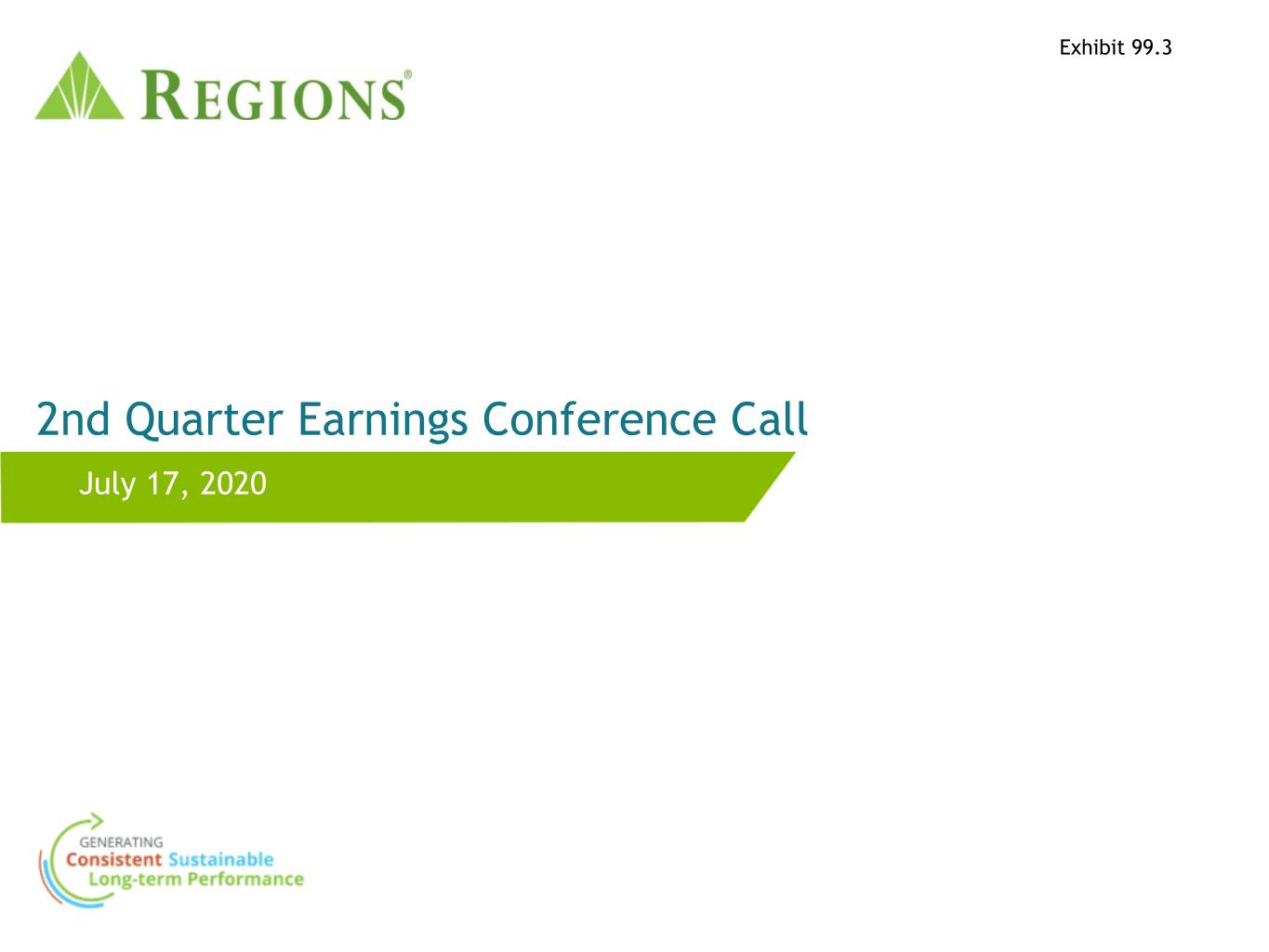
Exhibit 99.3 2nd Quarter Earnings Conference Call July 17, 2020
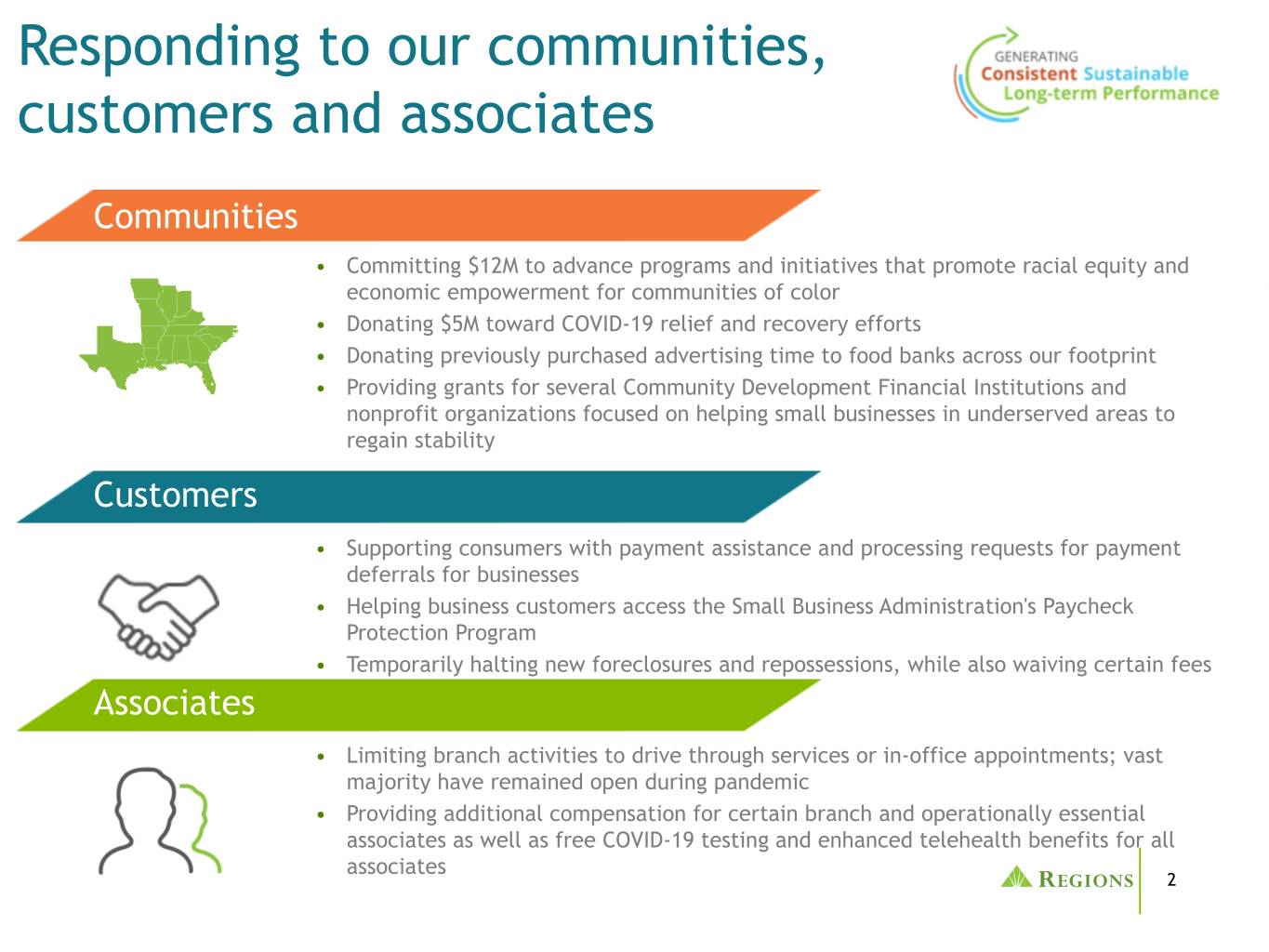
Responding to our communities, customers and associates Communities • Committing $12M to advance programs and initiatives that promote racial equity and economic empowerment for communities of color • Donating $5M toward COVID-19 relief and recovery efforts • Donating previously purchased advertising time to food banks across our footprint • Providing grants for several Community Development Financial Institutions and nonprofit organizations focused on helping small businesses in underserved areas to regain stability Customers • Supporting consumers with payment assistance and processing requests for payment deferrals for businesses • Helping business customers access the Small Business Administration's Paycheck Protection Program • Temporarily halting new foreclosures and repossessions, while also waiving certain fees Associates • Limiting branch activities to drive through services or in-office appointments; vast majority have remained open during pandemic • Providing additional compensation for certain branch and operationally essential associates as well as free COVID-19 testing and enhanced telehealth benefits for all associates 2
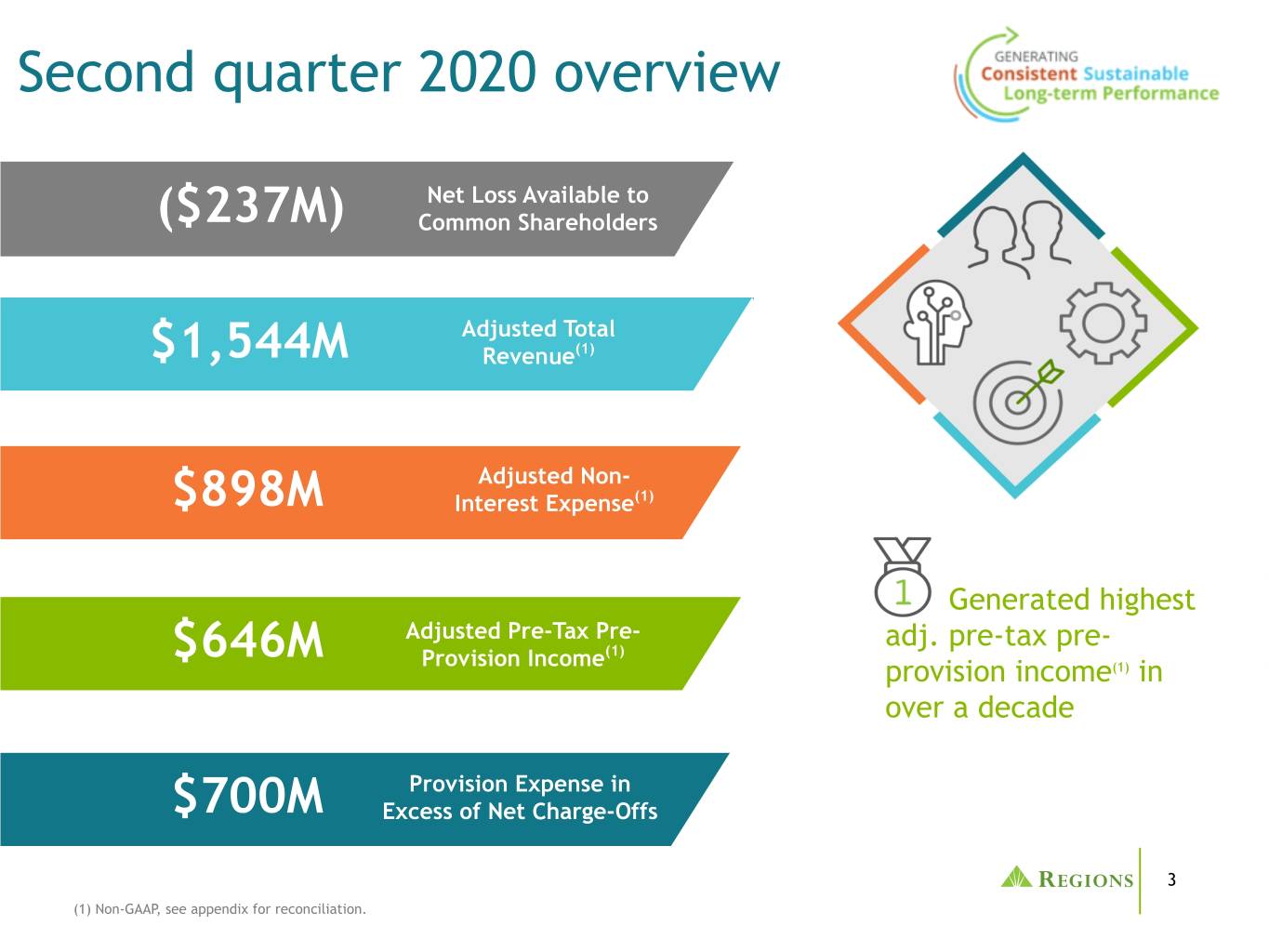
Second quarter 2020 overview Net Loss Available to ($237M) Common Shareholders Adjusted Total $1,544M Revenue(1) Adjusted Non- $898M Interest Expense(1) Generated highest Adjusted Pre-Tax Pre- adj. pre-tax pre- $646M Provision Income(1) provision income(1) in over a decade Provision Expense in $700M Excess of Net Charge-Offs 3 (1) Non-GAAP, see appendix for reconciliation.

Supporting our customers Customer Loan Modifications SBA-PPP Results (as of June 30, 2020) Balances w/ % making • Began receiving PPP Approx # of deferral ($ in Deferral as % payment in deferrals millions) of total last 61 days(1) applications April 3rd Mortgage (portfolio only) 5,500 $1,422 9% 34% ◦ Through July 8th, Home Equity 3,000 251 3% 36% funded ~45,000 Indirect-Vehicles(2) 4,000 102 8% 41% loans totaling ~ $5B Indirect-Other Consumer 5,500 84 3% NA(3) ◦ Average loan size Credit Card 5,000 27 2% 56% ~$106K Other Consumer 4,000 42 4% 37% ◦ 98% of funds to Total Consumer 27,000 1,928 6% companies with (4) Total Business 14,000 3,763 6% 25% <100 employees Total 41,000 $5,691 6% ◦ Supported over 600,000 jobs (1) Represents period from 5/1/20 to 7/1/20 based on count. (2) Indirect vehicles deferral metrics include Dealer Financial Services and 4 Direct auto only. (3) Limited information on payment in last 61 days for 3rd party portfolios serviced by others. (4) Business loan deferral metrics include Ascentium Capital. Percentage making payment in last 61 days represents Corp Banking Segment, excluding Ascentium.
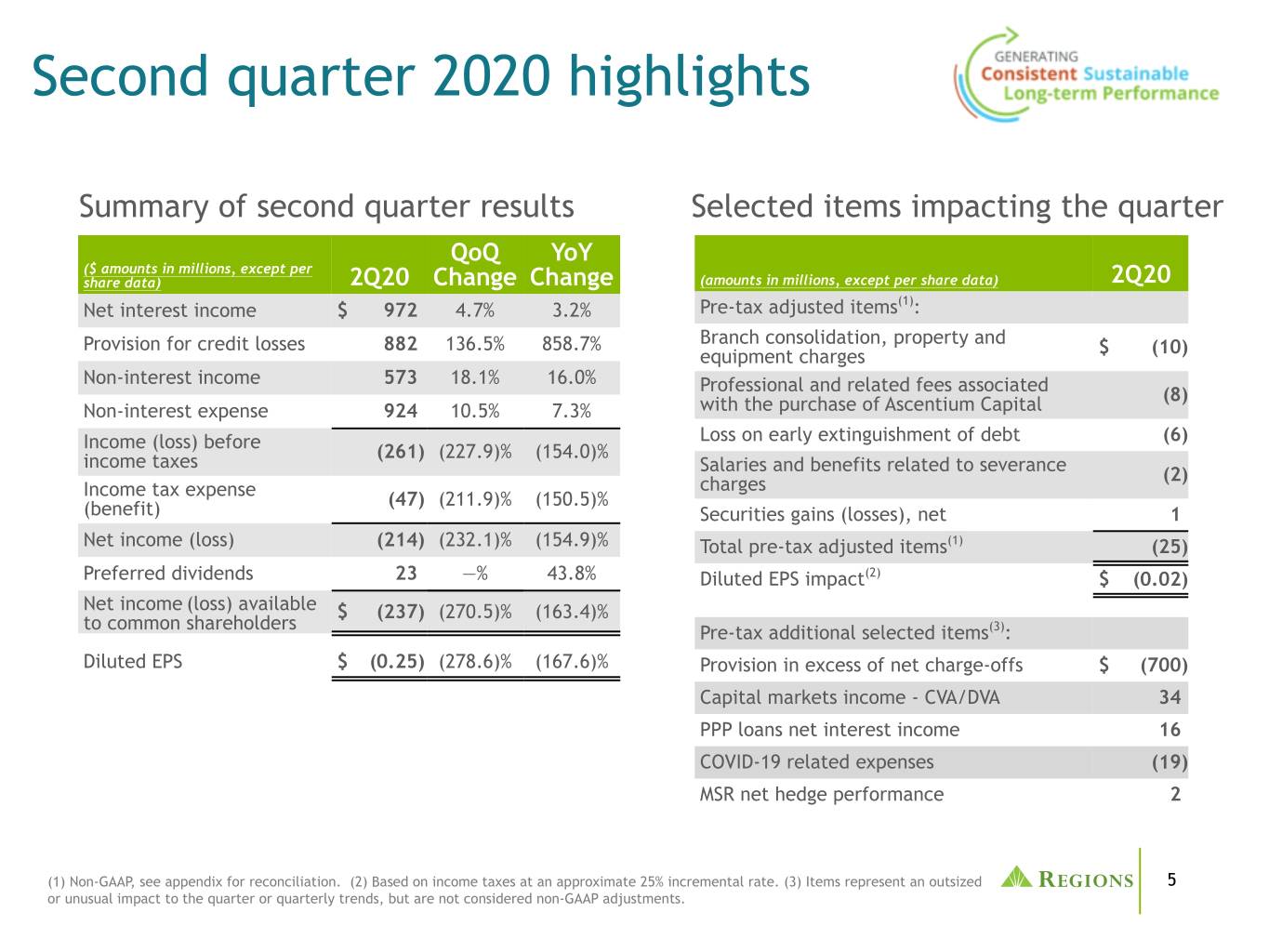
Second quarter 2020 highlights Summary of second quarter results Selected items impacting the quarter QoQ YoY ($ amounts in millions, except per share data) 2Q20 Change Change (amounts in millions, except per share data) 2Q20 (1) Net interest income $ 972 4.7% 3.2% Pre-tax adjusted items : Provision for credit losses 882 136.5% 858.7% Branch consolidation, property and equipment charges $ (10) Non-interest income 573 18.1% 16.0% Professional and related fees associated (8) Non-interest expense 924 10.5% 7.3% with the purchase of Ascentium Capital Income (loss) before Loss on early extinguishment of debt (6) (261) (227.9)% (154.0)% income taxes Salaries and benefits related to severance (2) Income tax expense charges (47) (211.9)% (150.5)% (benefit) Securities gains (losses), net 1 Net income (loss) (214) (232.1)% (154.9)% Total pre-tax adjusted items(1) (25) Preferred dividends 23 —% 43.8% Diluted EPS impact(2) $ (0.02) Net income (loss) available $ (237) (270.5)% (163.4)% to common shareholders (3) Pre-tax additional selected items : Diluted EPS $ (0.25) (278.6)% (167.6)% Provision in excess of net charge-offs $ (700) Capital markets income - CVA/DVA 34 PPP loans net interest income 16 COVID-19 related expenses (19) MSR net hedge performance 2 (1) Non-GAAP, see appendix for reconciliation. (2) Based on income taxes at an approximate 25% incremental rate. (3) Items represent an outsized 5 or unusual impact to the quarter or quarterly trends, but are not considered non-GAAP adjustments.

Average loans Adjusted average loans and leases(1) QoQ highlights ($ in billions) (1) $90.5 • Adjusted average loans increased 11% $81.3 $81.6 • Drivers of growth include elevated commercial draw activity early in the 28.4 quarter, acquisition of equipment finance 28.2 28.6 company Ascentium Capital, and PPP loans • Remain focused on client selectivity and full relationships with appropriate risk-adjusted returns • Commercial line utilization levels normalized 62.1 53.1 53.0 ending quarter at 44.6% • Expect PPP loan forgiveness requests to begin in 3Q and continue into 4Q • Mortgage balances benefited record 2Q19 1Q20 2Q20 production associated with historically low market interest rates Adjusted business loans(1) Adjusted consumer loans(1) 6 (1) Non-GAAP, see appendix for reconciliation.
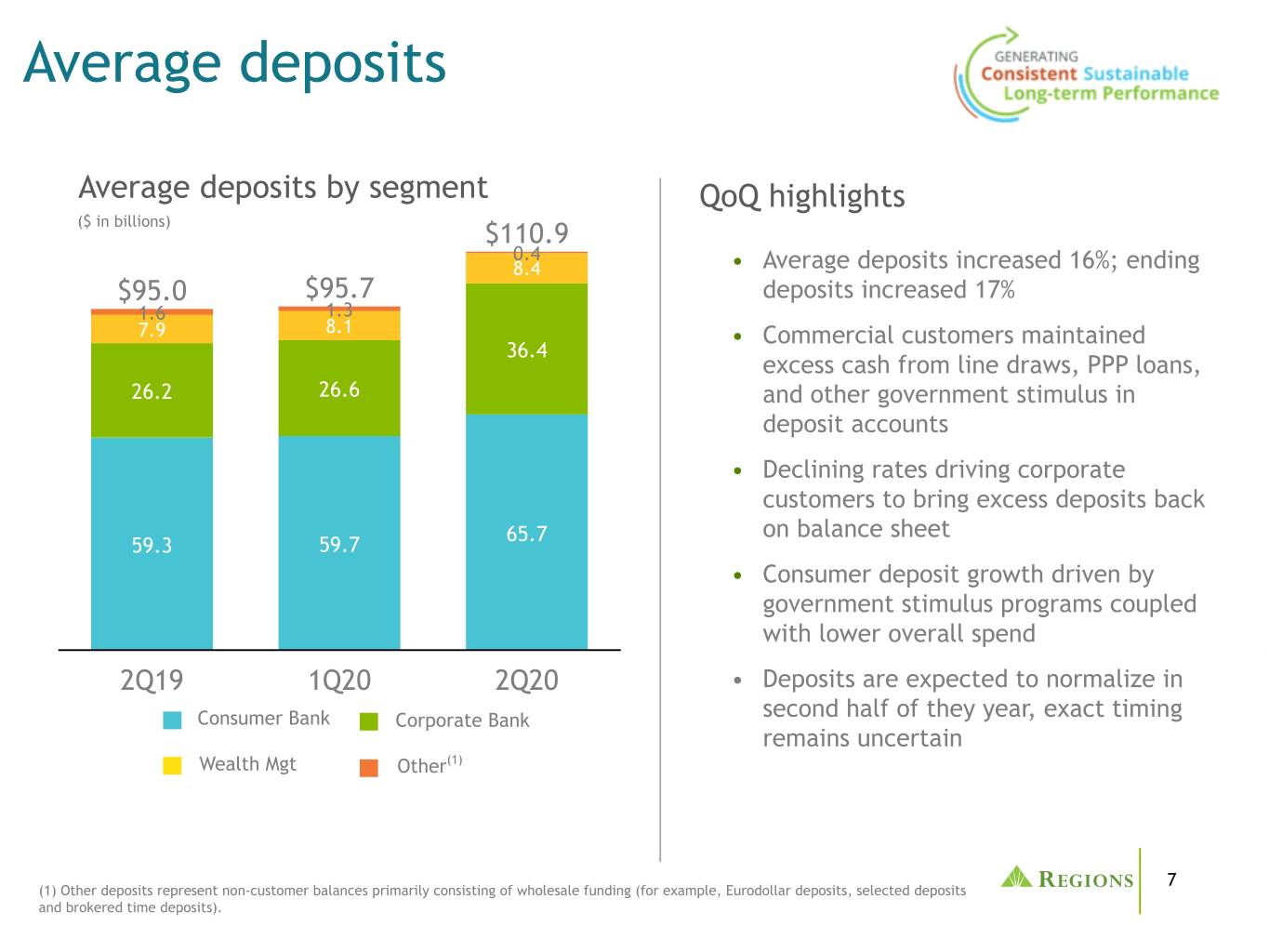
Average deposits Average deposits by segment QoQ highlights ($ in billions) $110.9 0.4 8.4 • Average deposits increased 16%; ending $95.0 $95.7 deposits increased 17% 1.6 1.3 7.9 8.1 • Commercial customers maintained 36.4 excess cash from line draws, PPP loans, 26.2 26.6 and other government stimulus in deposit accounts • Declining rates driving corporate customers to bring excess deposits back 65.7 on balance sheet 59.3 59.7 • Consumer deposit growth driven by government stimulus programs coupled with lower overall spend 2Q19 1Q20 2Q20 • Deposits are expected to normalize in Consumer Bank Corporate Bank second half of they year, exact timing remains uncertain Wealth Mgt Other(1) 7 (1) Other deposits represent non-customer balances primarily consisting of wholesale funding (for example, Eurodollar deposits, selected deposits and brokered time deposits).

Net interest income and net interest margin Liquidity Impacts in Near-term (1) • In 2Q, net interest income (NII) supported by elevated NII and NIM balance sheet from stimulus / liquidity in the system; net ($ in millions) interest margin (NIM) reduced $985 $956 $940 ◦ Elevated line-draws add ~2% NII and -4 bps NIM 3.45% 3.44% 3.38% ◦ PPP and cash account for -19 bps NIM degradation 3.19% ◦ $7.4B early FHLB extinguishment and $650M bank 2Q19 1Q20 2Q20 debt tender in the quarter directly reduce cash NII(1) NIM NIM excl. PPP/ Cash Drivers of Core Performance • No impact from short-term rate declines(2); protection from: ▪ Hedging program; $60M NII accrual in 2Q(3) NIM Attribution ▪ Deposit pricing advantage; 27% beta, -21 bps • Residual exposure to long-term rates at low levels(2) +10bps ▪ Fixed rate loan/securities production at lower rates 3.44% ▪ Premium amortization; from $26M 1Q to $33M 2Q -4bps -5bps • The Ascentium acquisition, credit costs, and loan cost -7bps accretion also impacted the quarter 3.19% 3Q 2020 Expectations -19bps • Core NII/NIM drivers(4) in 3Q are balance sheet deleveraging (normalization of line-draw), credit, and lower long-term rates; uncertain timing of PPP fee accel. to benefit NII/NIM 1Q20 Ascentium Comm. Lower Other PPP/Cash 2Q20 Acquisition Line Long-Term (Credit/ (2) • NII expected -1.5% to -2.5% in 3Q; expect ~$95M from hedges Draws Rates Loan Costs) • Excluding PPP/cash, NIM expected in mid-to-high 3.30%s (1) Net interest income on a fully taxable equivalent basis. (2) 1m LIBOR -1.05% QoQ; 10yr US Treasury -0.69% QoQ. (3) Hedges remain 8 active; $1.9B unrealized, pre-tax gain, to be amortized into NII over the remaining life of hedges ~5 years. (4) Assumes Fed Funds Target remains 0%-0.25%, 1m LIBOR 0.15%-0.25%, and 10yr US Treasury is range-bound 0.50% - 0.90%.
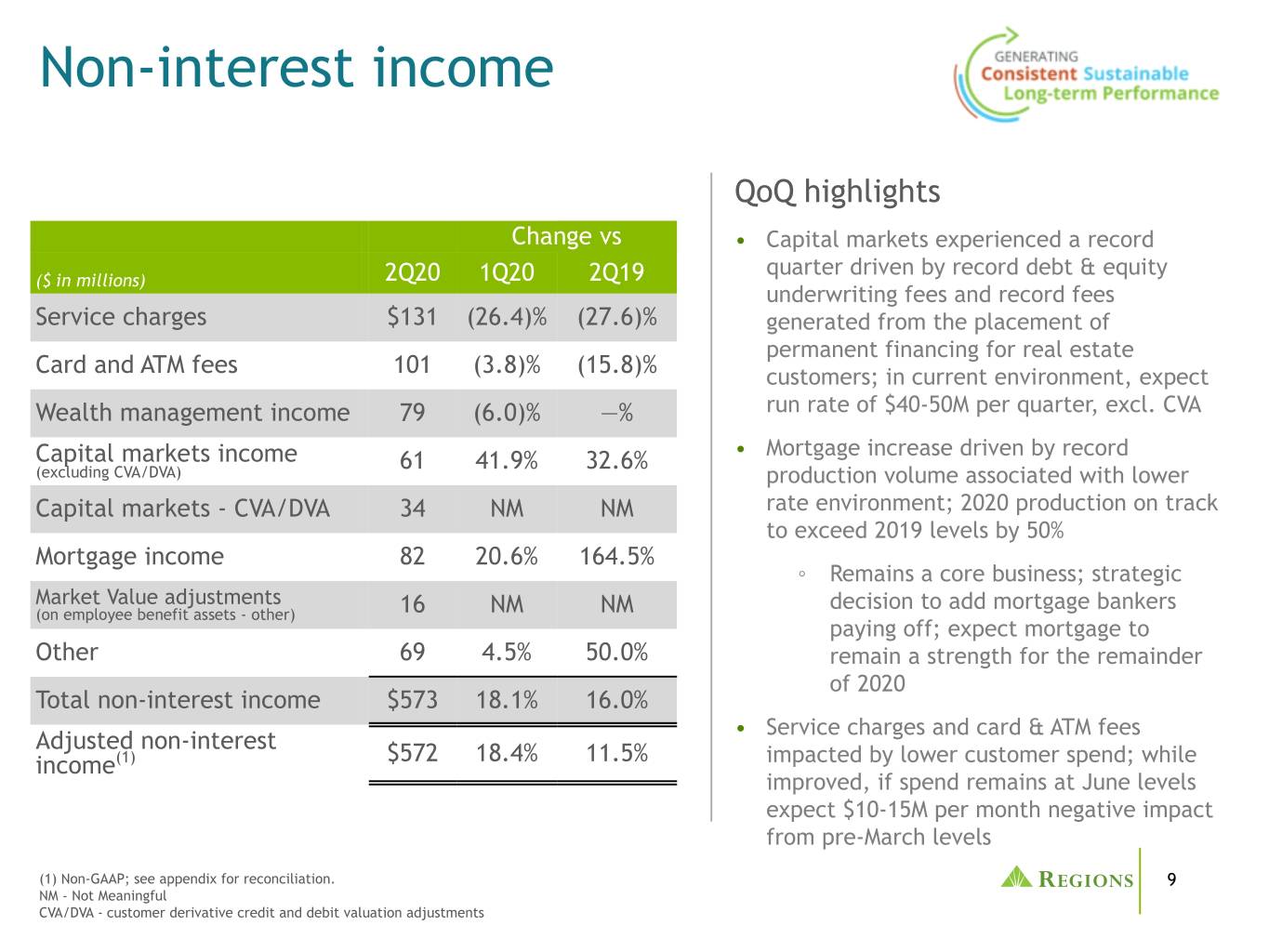
Non-interest income QoQ highlights Change vs • Capital markets experienced a record quarter driven by record debt & equity ($ in millions) 2Q20 1Q20 2Q19 underwriting fees and record fees Service charges $131 (26.4)% (27.6)% generated from the placement of permanent financing for real estate Card and ATM fees 101 (3.8)% (15.8)% customers; in current environment, expect Wealth management income 79 (6.0)% —% run rate of $40-50M per quarter, excl. CVA • Mortgage increase driven by record Capital markets income 61 41.9% 32.6% (excluding CVA/DVA) production volume associated with lower Capital markets - CVA/DVA 34 NM NM rate environment; 2020 production on track to exceed 2019 levels by 50% Mortgage income 82 20.6% 164.5% ◦ Remains a core business; strategic Market Value adjustments decision to add mortgage bankers (on employee benefit assets - other) 16 NM NM paying off; expect mortgage to Other 69 4.5% 50.0% remain a strength for the remainder of 2020 Total non-interest income $573 18.1% 16.0% • Service charges and card & ATM fees Adjusted non-interest income(1) $572 18.4% 11.5% impacted by lower customer spend; while improved, if spend remains at June levels expect $10-15M per month negative impact from pre-March levels (1) Non-GAAP; see appendix for reconciliation. 9 NM - Not Meaningful CVA/DVA - customer derivative credit and debit valuation adjustments

Non-interest expense Adjusted non-interest expense(1) QoQ highlights ($ in millions) $21 $898 • Salaries and benefits increased 13%, driven primarily by liability impact associated with $15 $(3) positive market value adjustments on $41 employee benefit accounts $824 ◦ Elevated production-based incentives, temporary COVID bonuses, the addition of 463 Ascentium associates and annual merit also contributed to the increase • Benefits from the Continuous Improvement process include reduced square footage, increased digital adoption, branch consolidations, and reduced 3rd-party spend • Evaluating digital and technology spend 1Q20 Chg. in Change Ascentium Other(2) 2Q20 market val. in COVID expenses priorities to align with recent changes in adj. on expenses customer behavior employee benefit • Committed to adjusting the expense base accounts commensurate with the revenue environment • 2Q20 adjusted efficiency ratio(1) improved 20 bps to 57.7% QoQ (1) Non-GAAP; see appendix for reconciliation. (2) Other includes increased incentive-based compensation associated with record 10 mortgage and capital markets income, as well as merit increases offset by expense reductions associated with loan origination cost deferrals and lower payroll taxes.

Asset quality Net charge-offs and ratio Criticized business loans ($ in millions) $182 ($ in millions) 132 0.80% $4,225 $123 63 $92 $2,524 0.59% $2,124 37 0.44% 55 60 50 2Q19 1Q20 2Q20 2Q19 1Q20 2Q20 Consumer net Business services Net charge-offs • No substantial reserve builds anticipated for remainder charge-offs net charge-offs ratio of 2020; near-term NCOs expected to remain in line with 2Q; 2Q NCOs increase reflects charges within NPLs and ACL coverage ratio energy & restaurant, as well as addition of Ascentium ($ in millions) $638 $614 • Provision $882M ($182M NCOs) resulting in ACL of 2.68% $533 of total loans (2.82%(1) ex-PPP) 395% ◦ Provision includes $64M initial reserves for non- 261% PCD loans in Ascentium acquisition 169% • Criticized business loans increased 67% reflecting 2Q19 1Q20 2Q20 downward risk-rating revisions for loan deferrals NPLs - excluding LHFS ACL coverage combined with downgrades within energy, restaurant, ratio hotel and retail (1) Non-GAAP; see appendix for reconciliation. 11

Bottom up review informs and narrows COVID-19 high-risk industry sectors (as of June 30, 2020) % of % Utilization Leveraged SNC % % C&I Portfolio BAL$(1) BAL$ (2) % of BAL$ % of BAL$ Deferral Criticized Energy – Oil & Gas Extraction, Oilfield Services $1.37b 1.5% 66% —% 80% 6% 48% Freight transportation – Local General Freight, Freight Arrangement $0.26b 0.3% 80% 6% —% 23% 5% Healthcare – Offices of Physicians and Other Health Practitioners $1.13b 1.2% 72% 4% 4% 32% 4% Other Consumer Services – Personal care services, Religious Organizations, Drycleaning & Laundry Services $0.46b 0.5% 75% —% —% 29% 8% Restaurants – Full service, Special Food Services $0.80b 0.9% 86% 21% 40% 29% 32% Retail (non-essential) – Clothing $0.25b 0.3% 67% —% 75% 11% 44% Travel and Leisure – Amusement, arts and recreation $0.65b 0.7% 80% 37% 48% 17% 17% Total $4.92b 5.4% 73% 10% 40% 21% 25% % of % Utilization Leveraged SNC % % CRE related exposures including unsecured C&I BAL$(1) BAL$ (2) % of BAL$ % of BAL$ Deferral Criticized Hotels – Full service, limited service, extended stay $0.98b 1.1% 81% —% 69% 18% 27% Retail (non-essential) – Primarily malls and outlet centers $2.53b 2.8% 65% —% 77% 9% 25% Total $3.51b 3.9% 69% —% 75% 11% 25% Ongoing Portfolio Surveillance • Proactive, frequent customer dialogue • Central reporting on enterprise-wide relief initiatives • Closely monitoring most vulnerable customers • Established pandemic related monitoring • Monitoring ratings migration • Deferral requests • Revolver draws 12 (1) Amounts exclude PPP Loans, Operating Leases and Held For Sale exposure. (2) Borrowing Base Adjusted Commitments, excludes Operating Leases and Held For Sale.

COVID-19 high-risk industry sectors waterfall ($ in billions) QoQ highlights $0.7 $2.3 • Based on a deep dive of our portfolios, COVID high-risk industries $12.4 were further refined to those exhibiting higher levels of stress due to COVID impact $8.4 $(6.3) • CRE Retail sector was updated to $(0.7) reflect all retail, not just malls(1) • Several sub-sectors were removed including but not limited to: ◦ Energy sub-sectors other than OFS and E&P 3/31/2020 Sector Ascentium Sub-Sector Other 6/30/2020 High-Risk Additions(1) Acquisition Deletions Activity(2) High-Risk ◦ Freight Transportation sub- Balances Balances sectors other than Trucking ◦ C&I Retail (non-essential) sub- sectors other than Clothing (1) CRE Retail sector was updated to reflect all retail, not just malls. (2) Other activity includes payments, charge-offs, new loans, moves to 13 held for sale and NAICs changes.
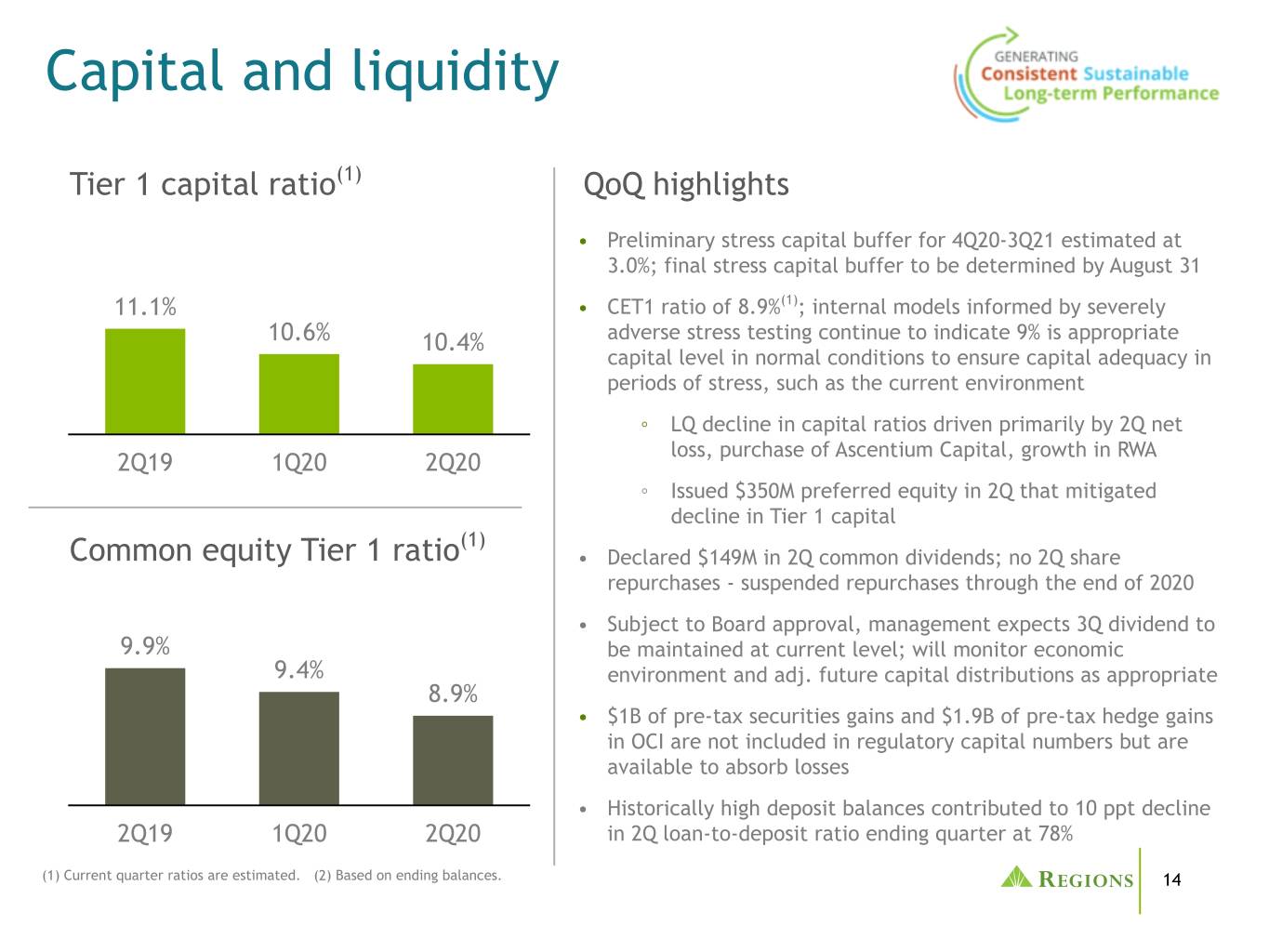
Capital and liquidity Tier 1 capital ratio(1) QoQ highlights • Preliminary stress capital buffer for 4Q20-3Q21 estimated at 3.0%; final stress capital buffer to be determined by August 31 11.1% • CET1 ratio of 8.9%(1); internal models informed by severely 10.6% 10.4% adverse stress testing continue to indicate 9% is appropriate capital level in normal conditions to ensure capital adequacy in periods of stress, such as the current environment ◦ LQ decline in capital ratios driven primarily by 2Q net loss, purchase of Ascentium Capital, growth in RWA 2Q19 1Q20 2Q20 ◦ Issued $350M preferred equity in 2Q that mitigated decline in Tier 1 capital (1) Common equity Tier 1 ratio • Declared $149M in 2Q common dividends; no 2Q share repurchases - suspended repurchases through the end of 2020 • Subject to Board approval, management expects 3Q dividend to 9.9% be maintained at current level; will monitor economic 9.4% environment and adj. future capital distributions as appropriate 8.9% • $1B of pre-tax securities gains and $1.9B of pre-tax hedge gains in OCI are not included in regulatory capital numbers but are available to absorb losses • Historically high deposit balances contributed to 10 ppt decline 2Q19 1Q20 2Q20 in 2Q loan-to-deposit ratio ending quarter at 78% (1) Current quarter ratios are estimated. (2) Based on ending balances. 14
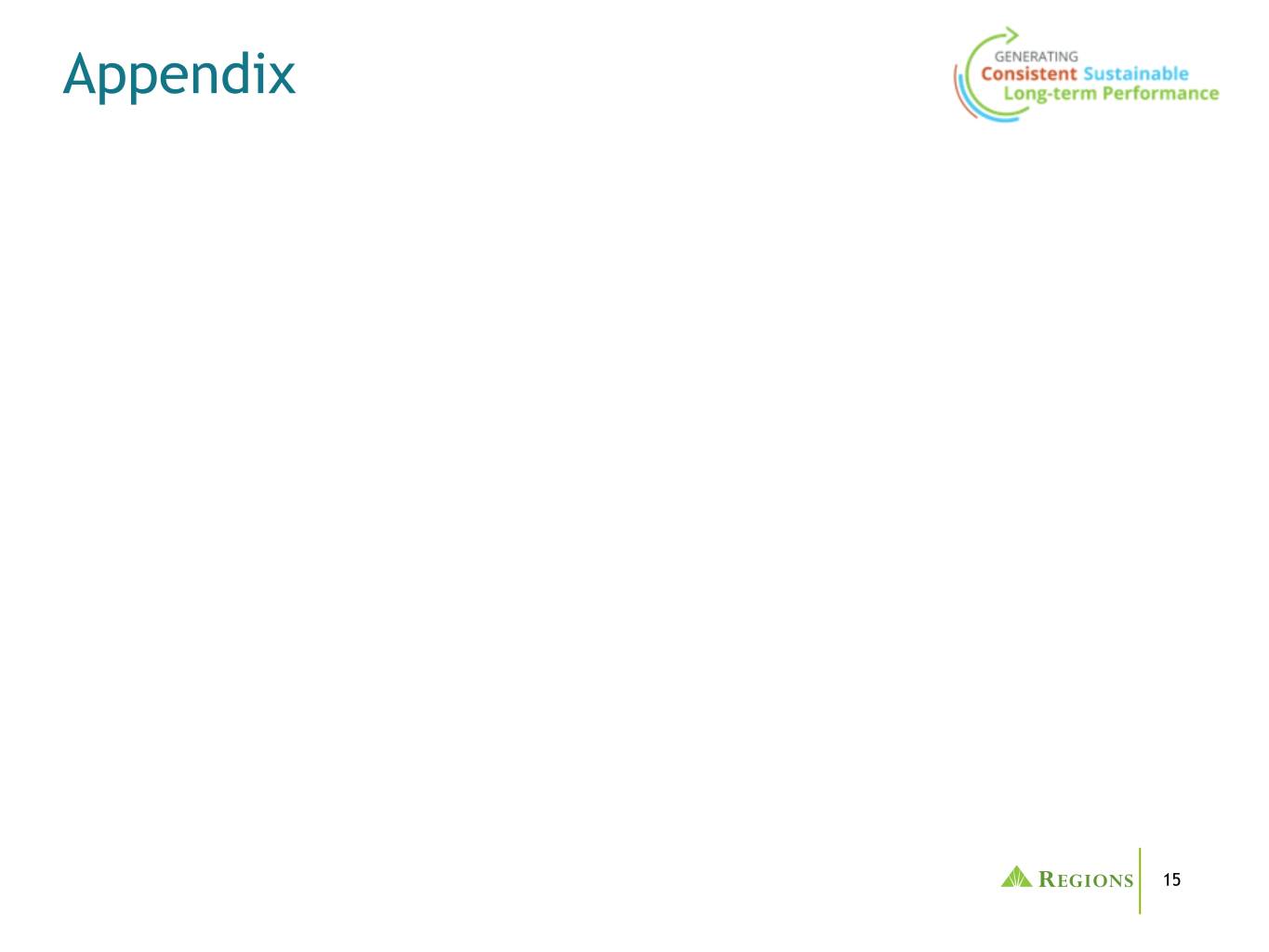
Appendix 15
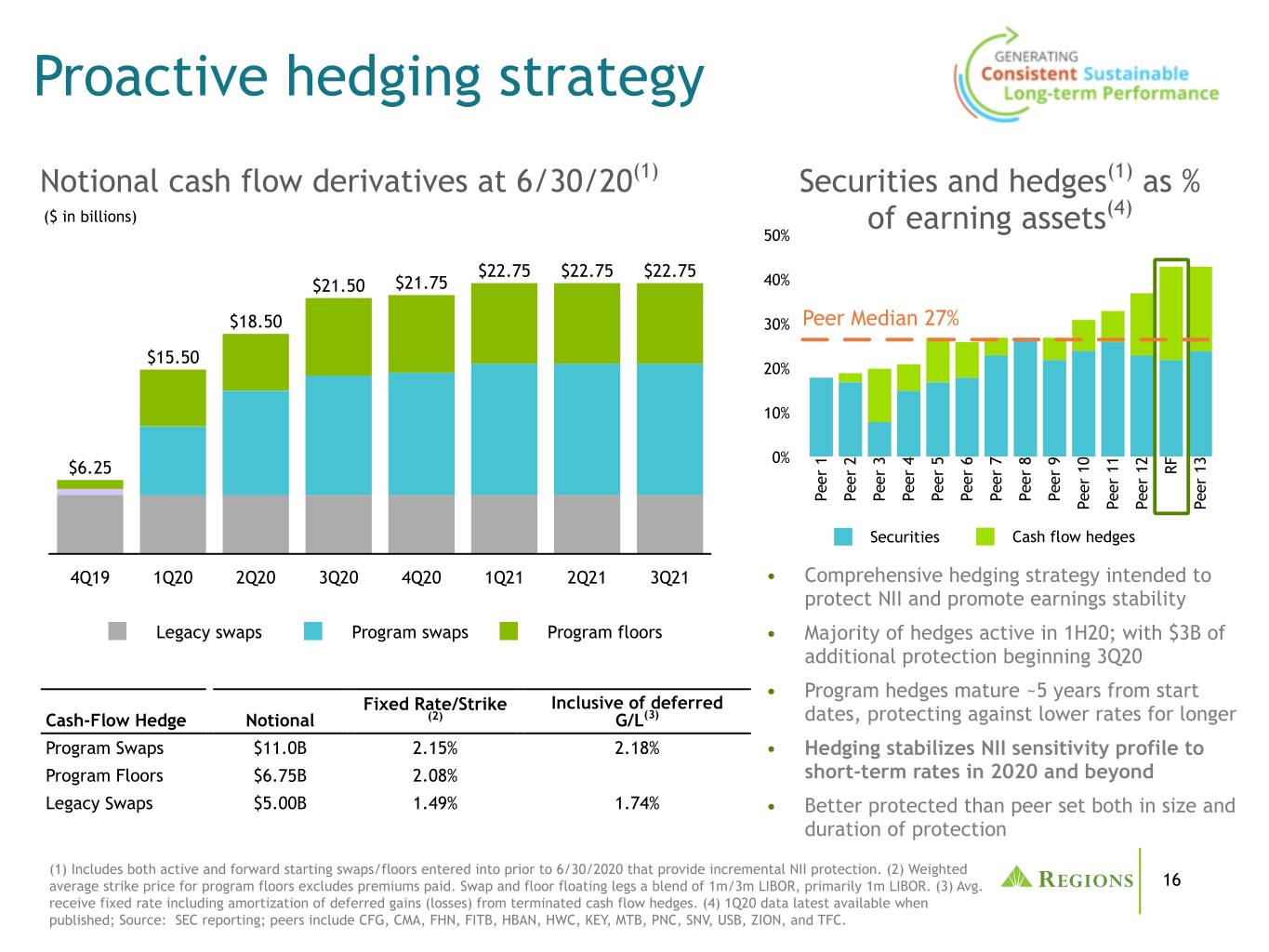
Proactive hedging strategy Notional cash flow derivatives at 6/30/20(1) Securities and hedges(1) as % (4) ($ in billions) of earning assets 50% $22.75 $22.75 $22.75 $21.50 $21.75 40% $18.50 30% Peer Median 27% $15.50 20% 10% 0 1 2 3 1 2 3 4 5 6 7 8 9 0% F 1 1 1 1 R $6.25 r r r r r r r r r r r r r e e e e e e e e e e e e e e e e e e e e e e e e e e P P P P P P P P P P P P P Securities Cash flow hedges 4Q19 1Q20 2Q20 3Q20 4Q20 1Q21 2Q21 3Q21 • Comprehensive hedging strategy intended to protect NII and promote earnings stability Legacy swaps Program swaps Program floors • Majority of hedges active in 1H20; with $3B of additional protection beginning 3Q20 • Program hedges mature ~5 years from start Fixed Rate/Strike Inclusive of deferred Cash-Flow Hedge Notional (2) G/L(3) dates, protecting against lower rates for longer Program Swaps $11.0B 2.15% 2.18% • Hedging stabilizes NII sensitivity profile to Program Floors $6.75B 2.08% short-term rates in 2020 and beyond Legacy Swaps $5.00B 1.49% 1.74% • Better protected than peer set both in size and duration of protection (1) Includes both active and forward starting swaps/floors entered into prior to 6/30/2020 that provide incremental NII protection. (2) Weighted average strike price for program floors excludes premiums paid. Swap and floor floating legs a blend of 1m/3m LIBOR, primarily 1m LIBOR. (3) Avg. 16 receive fixed rate including amortization of deferred gains (losses) from terminated cash flow hedges. (4) 1Q20 data latest available when published; Source: SEC reporting; peers include CFG, CMA, FHN, FITB, HBAN, HWC, KEY, MTB, PNC, SNV, USB, ZION, and TFC.

Interest rate exposure of future business and long-term rates Fixed / float loan mix(1) • The majority of Regions’ residual NII exposure to interest rates 100% comes from future business activities and cash-flow reinvestment; 90% full-year 2020 estimate: 80% 70% * ~$10.5B fixed-rate loan production 60% Peer median = 42% * ~$4B fixed-rate securities reinvestment 50% 40% • Balance sheet mix is a reasonable proxy for long-end rate sensitivity 30% 20% * Exposure to fixed-rate assets in-line with peers (~41% fixed 10% 0 1 2 3 1 2 3 4 5 6 7 8 9 excluding hedges) 0% F 1 1 1 1 R r r r r r r r r r r r r r e e e e e e e e e e e e e e e e e e e e e e e e e e P P P P P P P P P P P P P % Fixed % Variable (2) • Within the securities portfolio, reinvestment and premium Securities portfolio composition amortization contribute to a portion of Regions’ NII exposure to interest rates Corporate Bonds: 5.4% Agency/UST: 0.9% • Portfolio constructed to protect against lower market rates Non-Agency CMBS: 2.4% * 31% of securities portfolio in bullet-like collateral (CMBS, corporate bonds, and USTs), up from 27% at year-end 2018 Agency CMBS: * Purchase MBS with loan characteristics that offer prepayment 23.2% protection: lower loan balances, seasoning, and state-specific $25.2B geographic concentrations ▪ Book premium lower by over 32% since last time long-term rates hit lows in 2016 Agency MBS: 68.1% (1) 3/31/2020 data latest available; Source: SEC reporting, Call Report data for loan repricing within 1 year; Peers include CFG, CMA, FHN, FITB, 17 HBAN, HWC, KEY, MTB, PNC, SNV, USB, ZION, and TFC. (2) Includes AFS, the unrealized AFS gain, and HTM securities as of 6/30/2020.

CET1 Waterfall 0.6% 9.4% (0.1)% (0.3)% 8.9% (0.7)% Pre-tax pre- RWA/ Common Provision 1Q20 CET1% provision Ascentium/ 2Q20 CET1%(1) dividend expense income(2) Other Note: Provision expense includes the impact of CECL deferral 18 (1) Current quarter ratios are estimated. (2) Non-GAAP; see appendix for reconciliation.
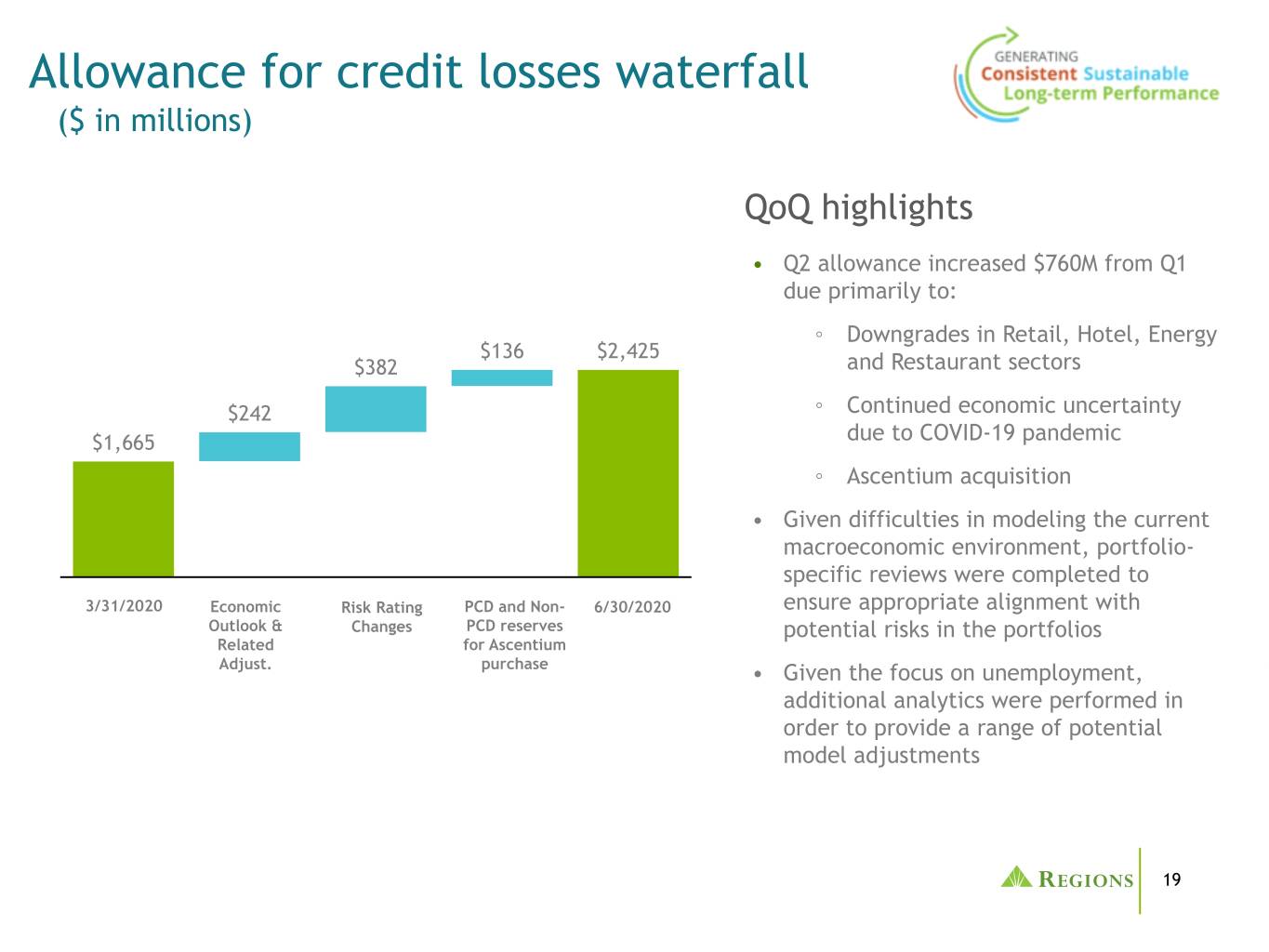
Allowance for credit losses waterfall ($ in millions) QoQ highlights • Q2 allowance increased $760M from Q1 due primarily to: ◦ Downgrades in Retail, Hotel, Energy $136 $2,425 $382 and Restaurant sectors $242 ◦ Continued economic uncertainty $1,665 due to COVID-19 pandemic ◦ Ascentium acquisition • Given difficulties in modeling the current macroeconomic environment, portfolio- specific reviews were completed to 3/31/2020 Economic Risk Rating PCD and Non- 6/30/2020 ensure appropriate alignment with Outlook & Changes PCD reserves potential risks in the portfolios Related for Ascentium Adjust. purchase • Given the focus on unemployment, additional analytics were performed in order to provide a range of potential model adjustments 19
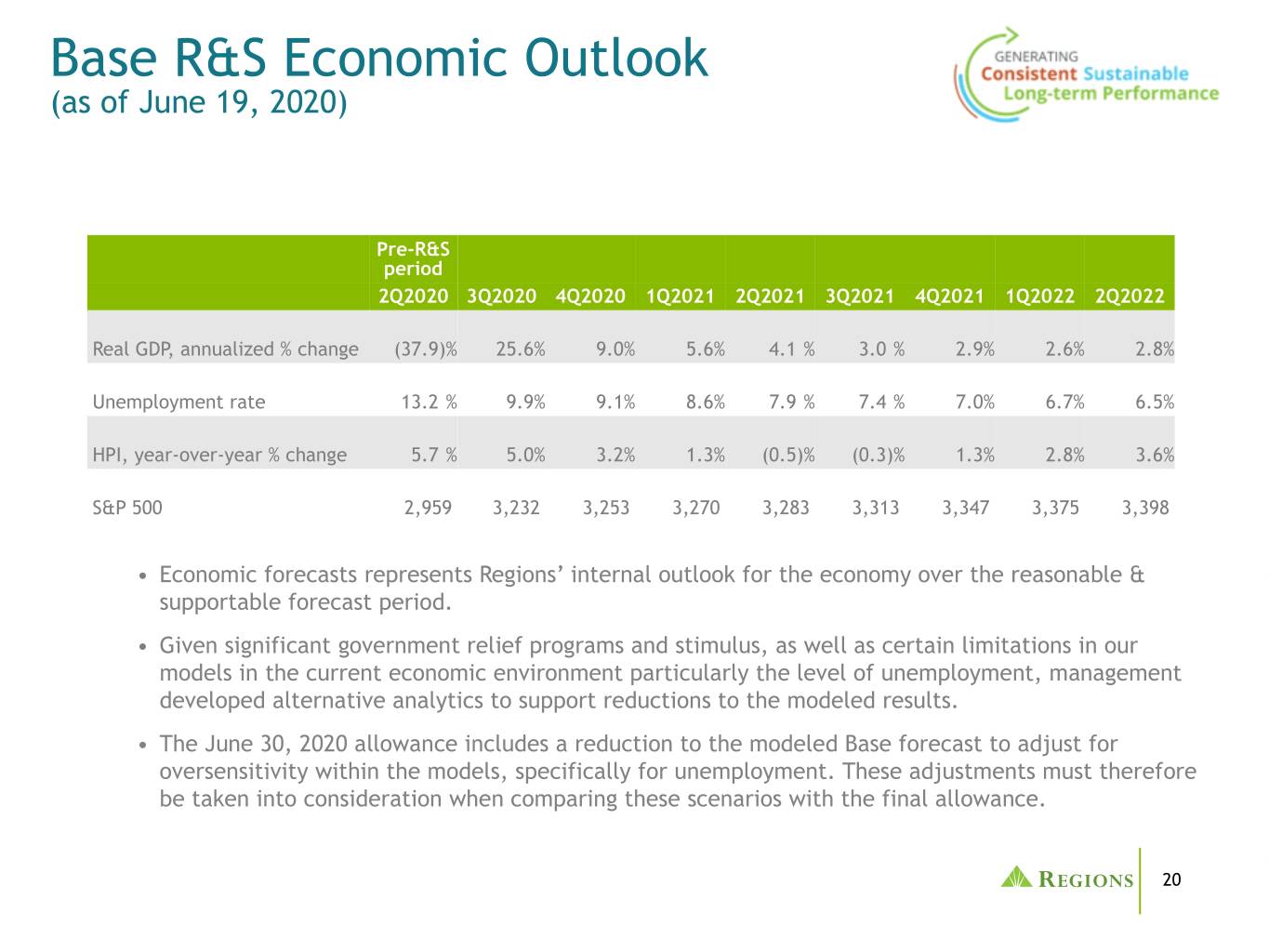
Base R&S Economic Outlook (as of June 19, 2020) Pre-R&S period 2Q2020 3Q2020 4Q2020 1Q2021 2Q2021 3Q2021 4Q2021 1Q2022 2Q2022 Real GDP, annualized % change (37.9)% 25.6% 9.0% 5.6% 4.1 % 3.0 % 2.9% 2.6% 2.8% Unemployment rate 13.2 % 9.9% 9.1% 8.6% 7.9 % 7.4 % 7.0% 6.7% 6.5% HPI, year-over-year % change 5.7 % 5.0% 3.2% 1.3% (0.5)% (0.3)% 1.3% 2.8% 3.6% S&P 500 2,959 3,232 3,253 3,270 3,283 3,313 3,347 3,375 3,398 • Economic forecasts represents Regions’ internal outlook for the economy over the reasonable & supportable forecast period. • Given significant government relief programs and stimulus, as well as certain limitations in our models in the current economic environment particularly the level of unemployment, management developed alternative analytics to support reductions to the modeled results. • The June 30, 2020 allowance includes a reduction to the modeled Base forecast to adjust for oversensitivity within the models, specifically for unemployment. These adjustments must therefore be taken into consideration when comparing these scenarios with the final allowance. 20
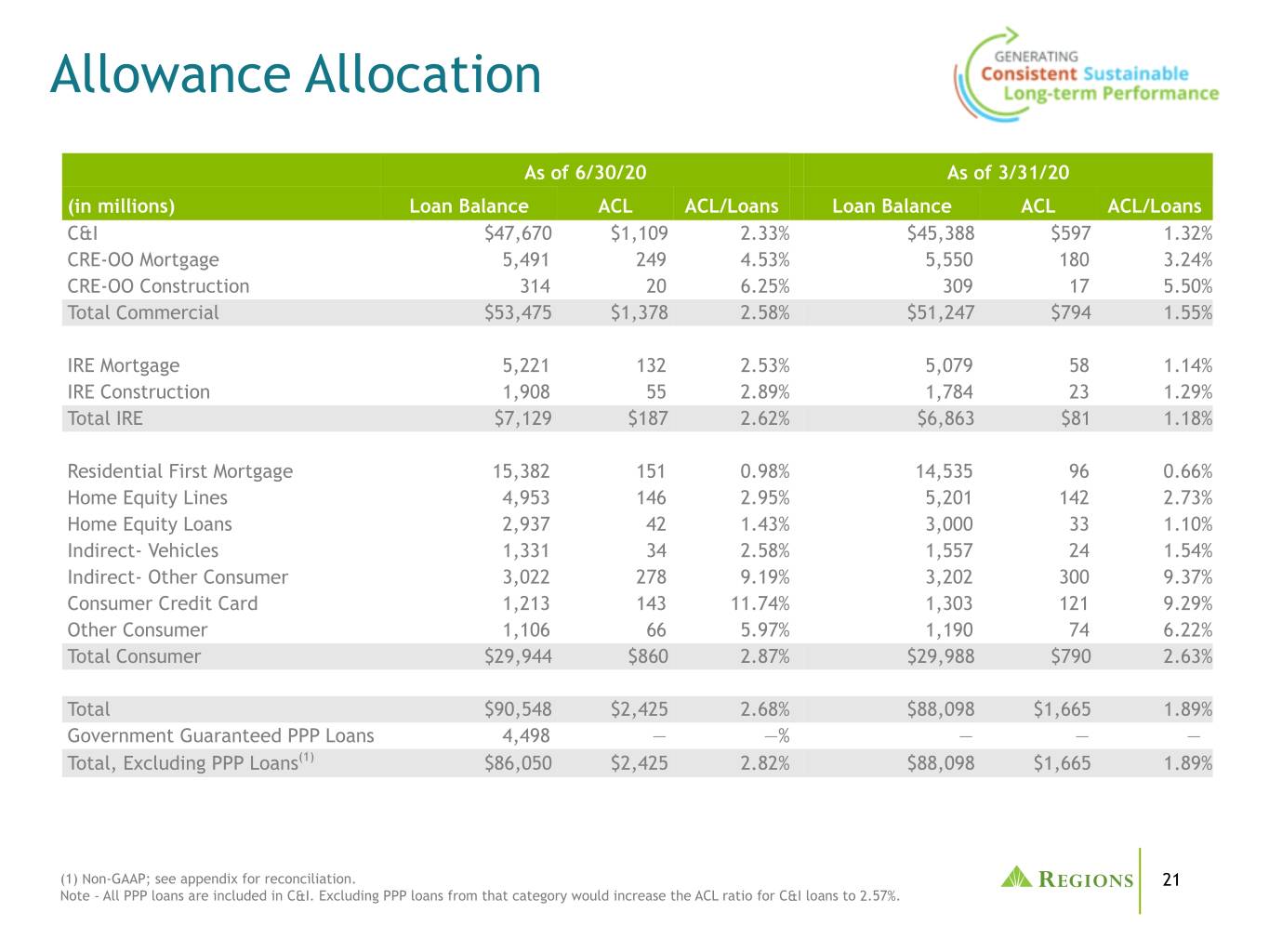
Allowance Allocation As of 6/30/20 As of 3/31/20 (in millions) Loan Balance ACL ACL/Loans Loan Balance ACL ACL/Loans C&I $47,670 $1,109 2.33% $45,388 $597 1.32% CRE-OO Mortgage 5,491 249 4.53% 5,550 180 3.24% CRE-OO Construction 314 20 6.25% 309 17 5.50% Total Commercial $53,475 $1,378 2.58% $51,247 $794 1.55% IRE Mortgage 53 5,221 132 2.53% 5,079 58 1.14% IRE Construction 1,908 55 2.89% 1,784 23 1.29% Total IRE $7,129 $187 2.62% $6,863 $81 1.18% Residential First Mortgage 15,382 151 0.98% 14,535 96 0.66% Home Equity Lines 4,953 146 2.95% 5,201 142 2.73% Home Equity Loans 2,937 42 1.43% 3,000 33 1.10% Indirect- Vehicles 1,331 34 2.58% 1,557 24 1.54% Indirect- Other Consumer 3,022 278 9.19% 3,202 300 9.37% Consumer Credit Card 1,213 143 11.74% 1,303 121 9.29% Other Consumer 1,106 66 5.97% 1,190 74 6.22% Total Consumer $29,944 $860 2.87% $29,988 $790 2.63% Total $90,548 $2,425 2.68% $88,098 $1,665 1.89% Government Guaranteed PPP Loans 4,498 — —% — — — Total, Excluding PPP Loans(1) $86,050 $2,425 2.82% $88,098 $1,665 1.89% (1) Non-GAAP; see appendix for reconciliation. 21 Note - All PPP loans are included in C&I. Excluding PPP loans from that category would increase the ACL ratio for C&I loans to 2.57%.
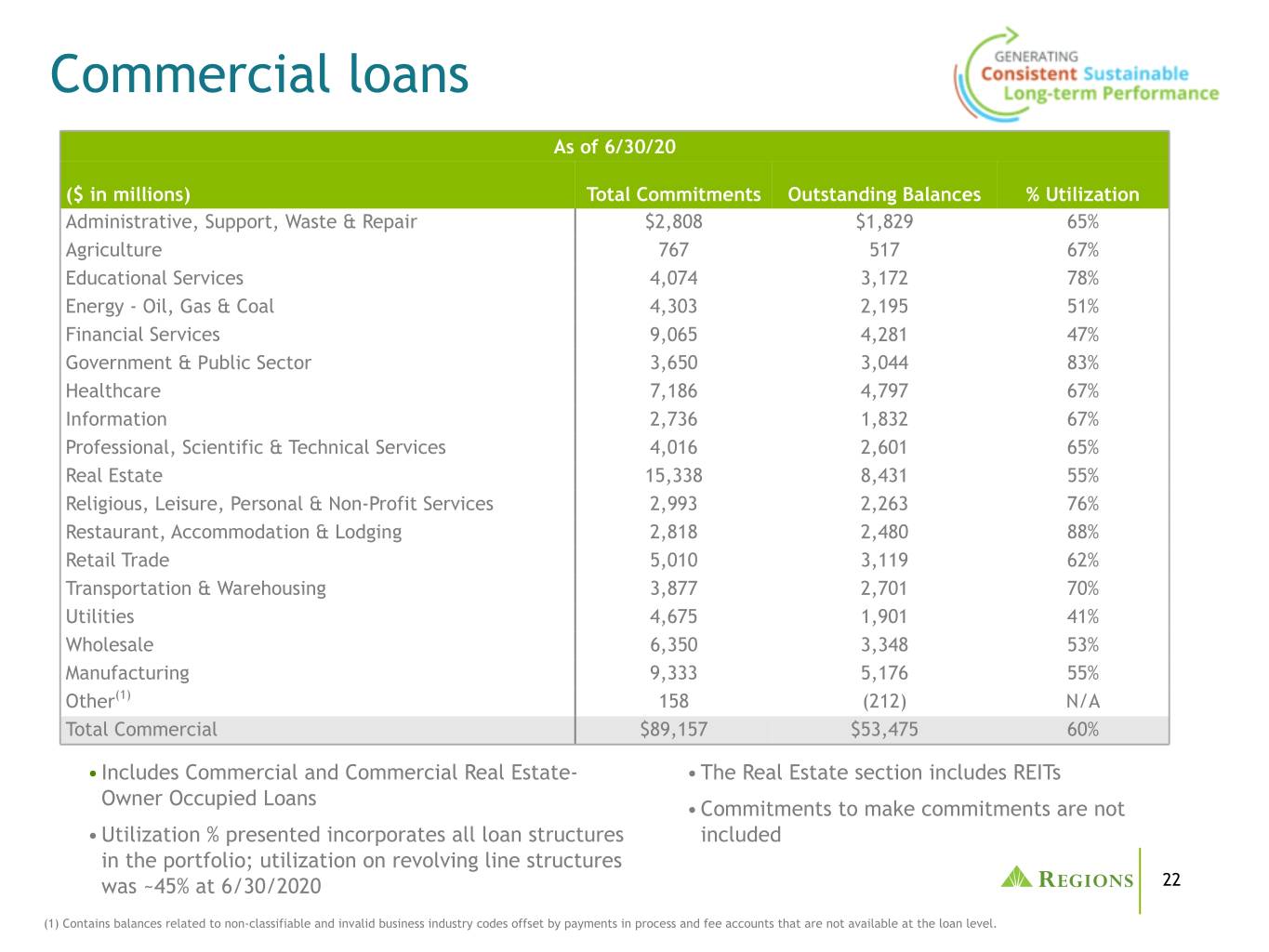
Commercial loans As of 6/30/20 ($ in millions) Total Commitments Outstanding Balances % Utilization Administrative, Support, Waste & Repair $2,808 $1,829 65% Agriculture 767 517 67% Educational Services 4,074 3,172 78% Energy - Oil, Gas & Coal 4,303 2,195 51% Financial Services 9,065 4,281 47% Government & Public Sector 53 3,650 3,044 83% Healthcare 7,186 4,797 67% Information 2,736 1,832 67% Professional, Scientific & Technical Services 4,016 2,601 65% Real Estate 15,338 8,431 55% Religious, Leisure, Personal & Non-Profit Services 2,993 2,263 76% Restaurant, Accommodation & Lodging 2,818 2,480 88% Retail Trade 5,010 3,119 62% Transportation & Warehousing 3,877 2,701 70% Utilities 4,675 1,901 41% Wholesale 6,350 3,348 53% Manufacturing 9,333 5,176 55% Other(1) 158 (212) N/A Total Commercial $89,157 $53,475 60% • Includes Commercial and Commercial Real Estate- • The Real Estate section includes REITs Owner Occupied Loans • Commitments to make commitments are not • Utilization % presented incorporates all loan structures included in the portfolio; utilization on revolving line structures was ~45% at 6/30/2020 22 (1) Contains balances related to non-classifiable and invalid business industry codes offset by payments in process and fee accounts that are not available at the loan level.

Leveraged portfolio (outstanding balances as of June 30, 2020) Leveraged Balances by Industry Leverage Definition • Regions Leveraged Lending Definition - $6.1B in balances Professional • Commitments are $10M Services 17% • Leverage exceeds 3x senior debt; 4x total debt Information 13% • Includes investment & non-investment grade loans Manufacturing 10% (1) 17% 17% • Moody’s 2018 Regional Bank Survey Definition - $3.0B in Healthcare 10% outstanding balances Financial Services • Regions’ leveraged lending exposure just below the peer 7% 9% (1) 13% average $6.1B Wholesale 9% 8% Religious, Leisure, Important Factors 10% Personal & Non- 9% Profit Services 8% • 10% • Not a strategic growth objective; used to support client 9% Restaurant, Accommodation & relationships Lodging 7% • Sponsor-owned clients as a percentage of total portfolio Other 17% continue to decline (Portfolios <7% of total) • Enhanced centralized underwriting, servicing, and credit adjudication • Very limited participation in the highest risk segments of leveraged loans - Covenant Lite & Term Loan B • Approximately 81% of leveraged loans outstanding are also SNCs 23 (1) As measured against TCE. Moody’s Investor Services – “Regional banks’ leveraged loan exposures are modest but growing”

SNC portfolio (outstanding balances as of June 30, 2020) Shared National Credit Balances by Industry 9% • Portfolio Characteristics 9% • Diverse industry mix 9% 47% $21.5B • 31% of balances are investment grade 8% • 23% of balances are leveraged 6% • 24% of balances are sponsor-backed 6% 6% • 8% of SNC balances are criticized Financial Services 9% Retail 9% Energy 9% Manufacturing 8% Information 6% Wholesale 6% Healthcare 6% Other 47% (Portfolios <6% of total) 24
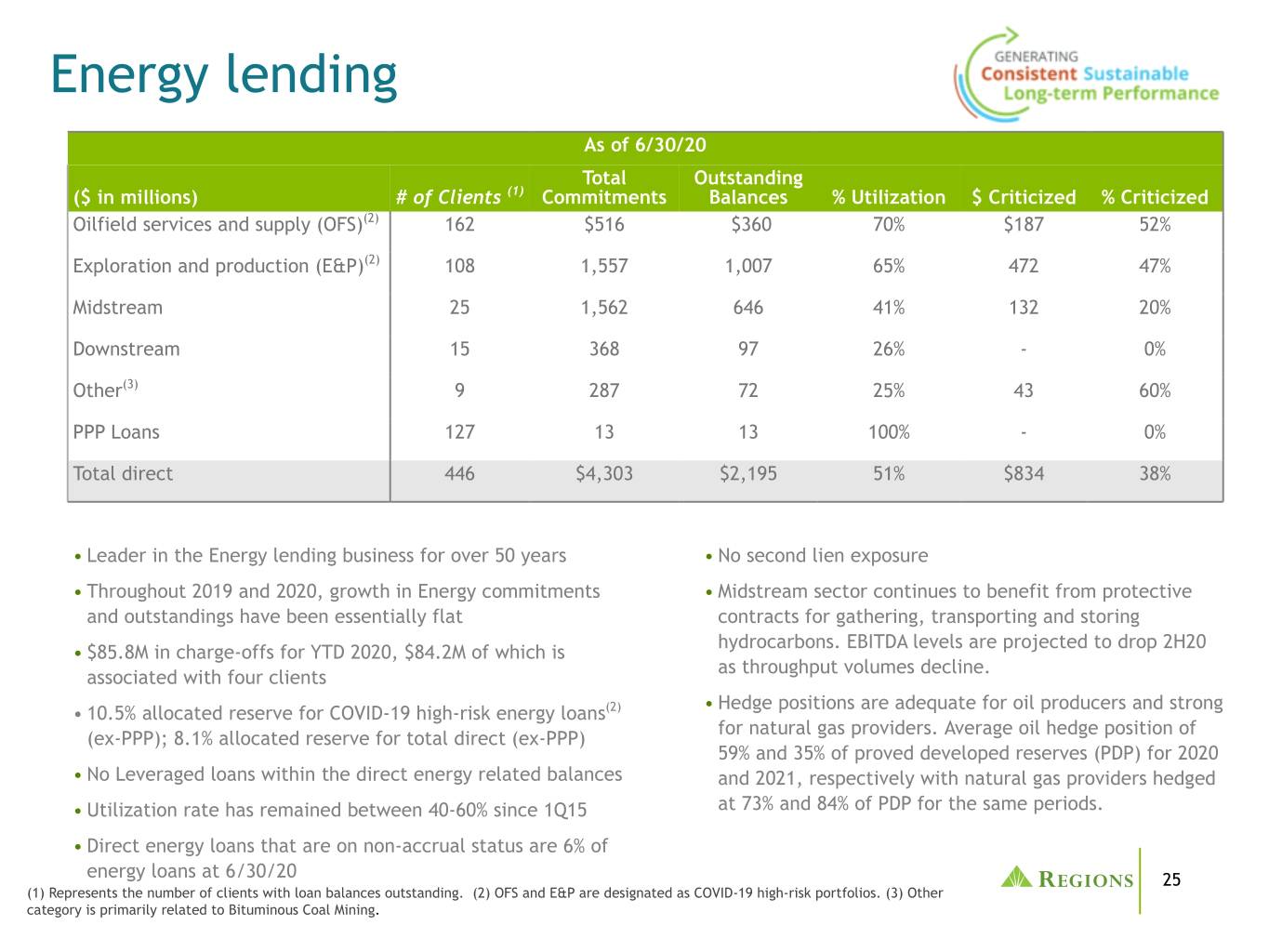
Energy lending As of 6/30/20 Total Outstanding ($ in millions) # of Clients (1) Commitments Balances % Utilization $ Criticized % Criticized Oilfield services and supply (OFS)(2) 162 $516 $360 70% $187 52% Exploration and production (E&P)(2) 108 1,557 1,007 65% 472 47% Midstream 25 1,562 646 41% 132 20% Downstream 15 368 97 26% - 0% 53 Other(3) 9 287 72 25% 43 60% PPP Loans 127 13 13 100% - 0% Total direct 446 $4,303 $2,195 51% $834 38% • Leader in the Energy lending business for over 50 years • No second lien exposure • Throughout 2019 and 2020, growth in Energy commitments • Midstream sector continues to benefit from protective and outstandings have been essentially flat contracts for gathering, transporting and storing hydrocarbons. EBITDA levels are projected to drop 2H20 • $85.8M in charge-offs for YTD 2020, $84.2M of which is as throughput volumes decline. associated with four clients • Hedge positions are adequate for oil producers and strong • 10.5% allocated reserve for COVID-19 high-risk energy loans(2) for natural gas providers. Average oil hedge position of (ex-PPP); 8.1% allocated reserve for total direct (ex-PPP) 59% and 35% of proved developed reserves (PDP) for 2020 • No Leveraged loans within the direct energy related balances and 2021, respectively with natural gas providers hedged • Utilization rate has remained between 40-60% since 1Q15 at 73% and 84% of PDP for the same periods. • Direct energy loans that are on non-accrual status are 6% of energy loans at 6/30/20 25 (1) Represents the number of clients with loan balances outstanding. (2) OFS and E&P are designated as COVID-19 high-risk portfolios. (3) Other category is primarily related to Bituminous Coal Mining.
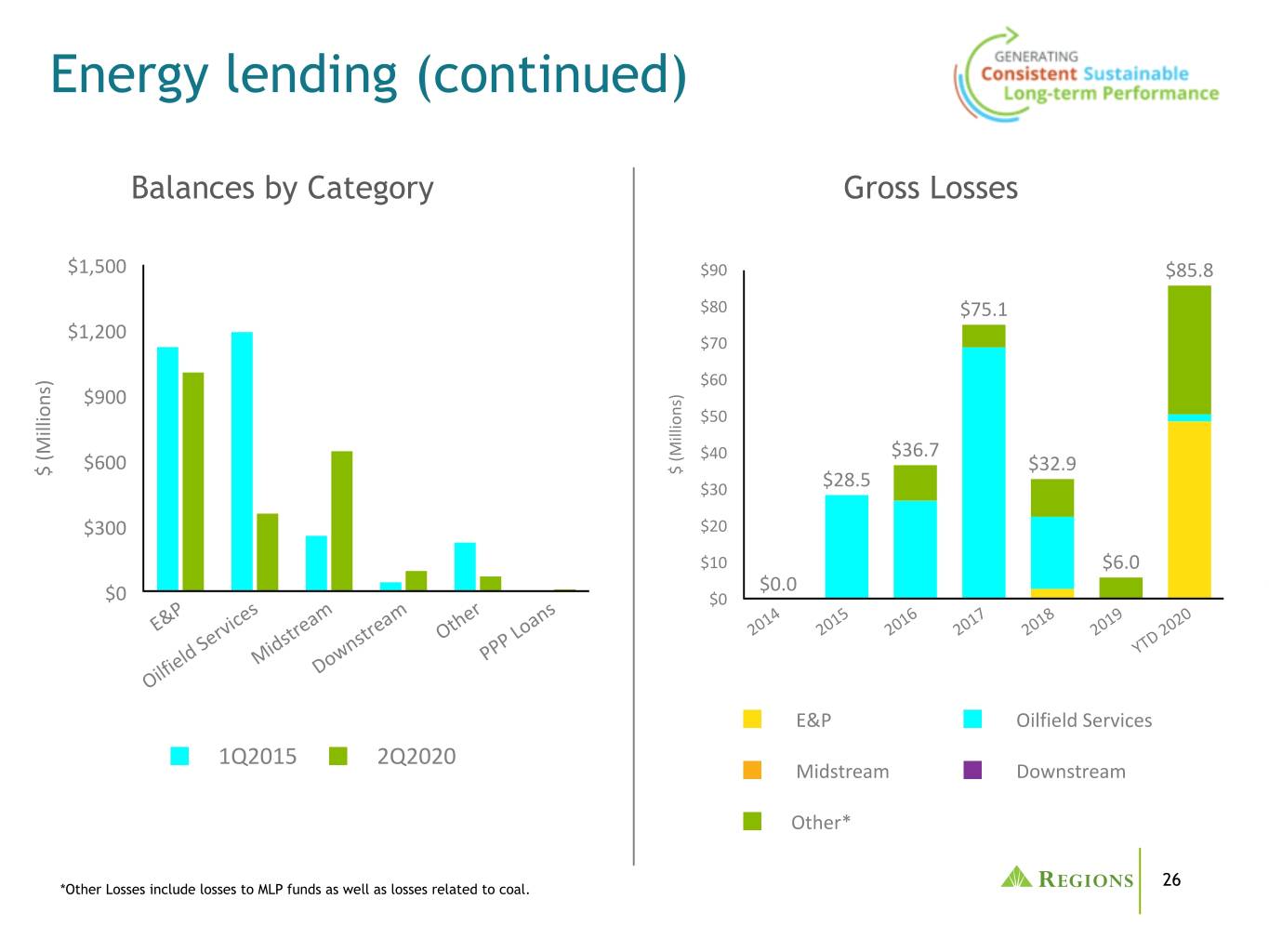
Energy lending (continued) Balances by Category Gross Losses $1,500 $90 $85.8 $80 $75.1 $1,200 $70 53 ) $60 s ) n $900 s n o i o $50 l i l l i l i M M ( ( $36.7 $600 $40 $ $32.9 $ $30 $28.5 $300 $20 $10 $6.0 $0.0 $0 $0 P es m m er ns 4 5 6 7 8 9 0 E& ic a a th a 01 01 01 01 01 01 02 rv tre tre O Lo 2 2 2 2 2 2 2 Se s s P TD d id wn P Y el M o P lfi D Oi E&P Oilfield Services 1Q2015 2Q2020 Midstream Downstream Other* 26 *Other Losses include losses to MLP funds as well as losses related to coal.
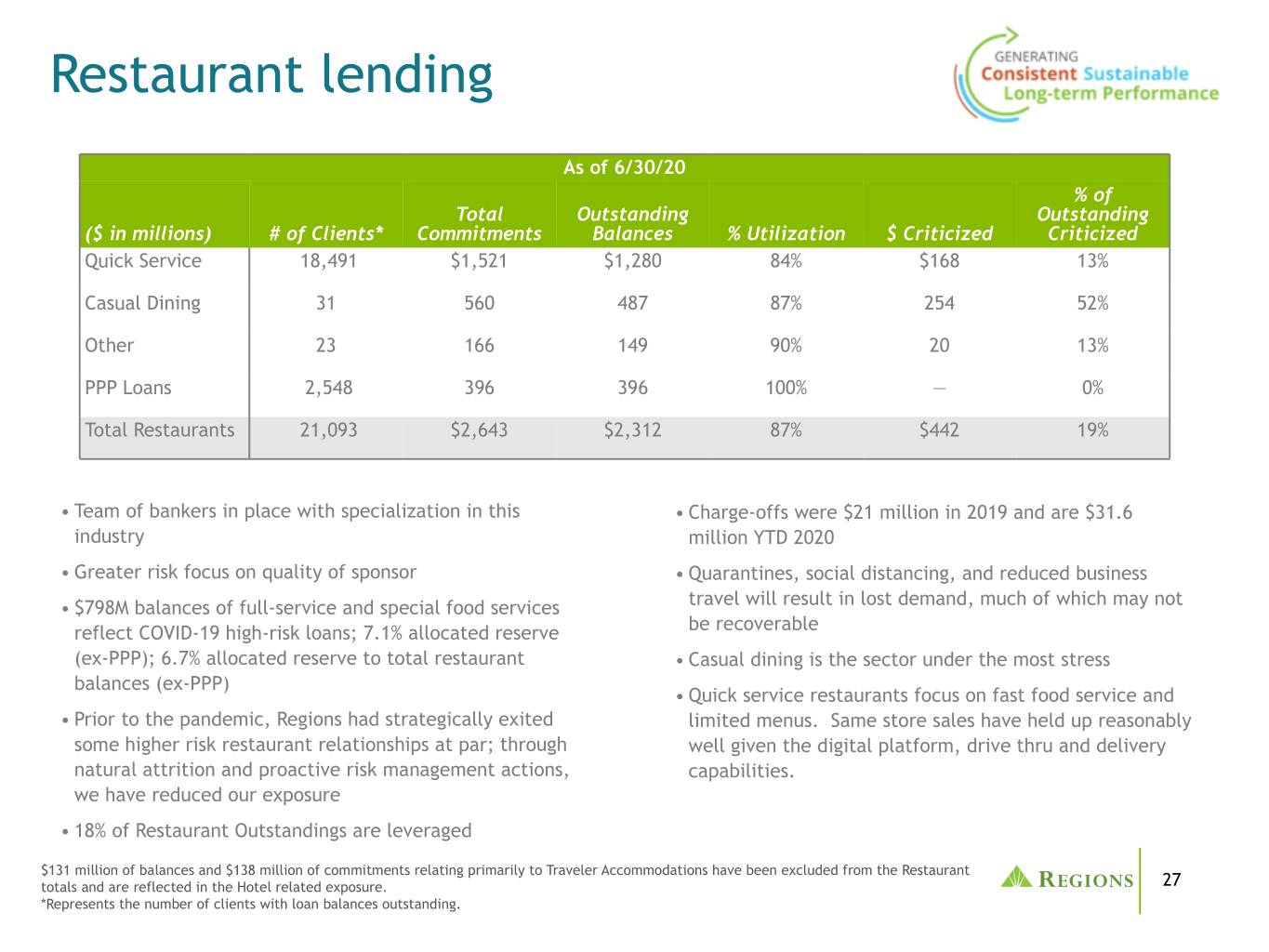
Restaurant lending As of 6/30/20 % of Total Outstanding Outstanding ($ in millions) # of Clients* Commitments Balances % Utilization $ Criticized Criticized Quick Service 18,491 $1,521 $1,280 84% $168 13% Casual Dining 31 560 487 87% 254 52% Other 23 166 149 90% 20 13% 53 PPP Loans 2,548 396 396 100% — 0% Total Restaurants 21,093 $2,643 $2,312 87% $442 19% • Team of bankers in place with specialization in this • Charge-offs were $21 million in 2019 and are $31.6 industry million YTD 2020 • Greater risk focus on quality of sponsor • Quarantines, social distancing, and reduced business • $798M balances of full-service and special food services travel will result in lost demand, much of which may not reflect COVID-19 high-risk loans; 7.1% allocated reserve be recoverable (ex-PPP); 6.7% allocated reserve to total restaurant • Casual dining is the sector under the most stress balances (ex-PPP) • Quick service restaurants focus on fast food service and • Prior to the pandemic, Regions had strategically exited limited menus. Same store sales have held up reasonably some higher risk restaurant relationships at par; through well given the digital platform, drive thru and delivery natural attrition and proactive risk management actions, capabilities. we have reduced our exposure • 18% of Restaurant Outstandings are leveraged $131 million of balances and $138 million of commitments relating primarily to Traveler Accommodations have been excluded from the Restaurant totals and are reflected in the Hotel related exposure. 27 *Represents the number of clients with loan balances outstanding.

Hotel lending As of 6/30/20 % of Total Outstanding Outstanding ($ in millions) # of Clients* Commitments Balances % Utilization $ Criticized Criticized CRE-Unsecured 12 $888 $714 80% $0 0% IRE – Mortgage 17 247 238 96% 236 99% IRE – Construction 3 53 80 31 39% 31 100% Consumer Services 3,666 138 131 95% 1 1% PPP Loans 329 37 37 100% — 0% Total Hotel related 4,027 $1,390 $1,151 83% $268 23% • CRE – Unsecured outstanding balance is comprised of 12 REIT customers • 59% of total hotel related loans are SNCs • The REIT portfolio benefits from low leverage, strong liquidity, and diversity of property holdings. Companies have also taken proactive steps to reduce CAPEX, cut dividends, and reduce overhead to preserve cash. *Represents the number of clients with loan balances outstanding Consumer services represents amounts relating primarily to Traveler Accommodations that have been excluded from the Restaurant totals and are 28 reflected in the Hotel related exposure
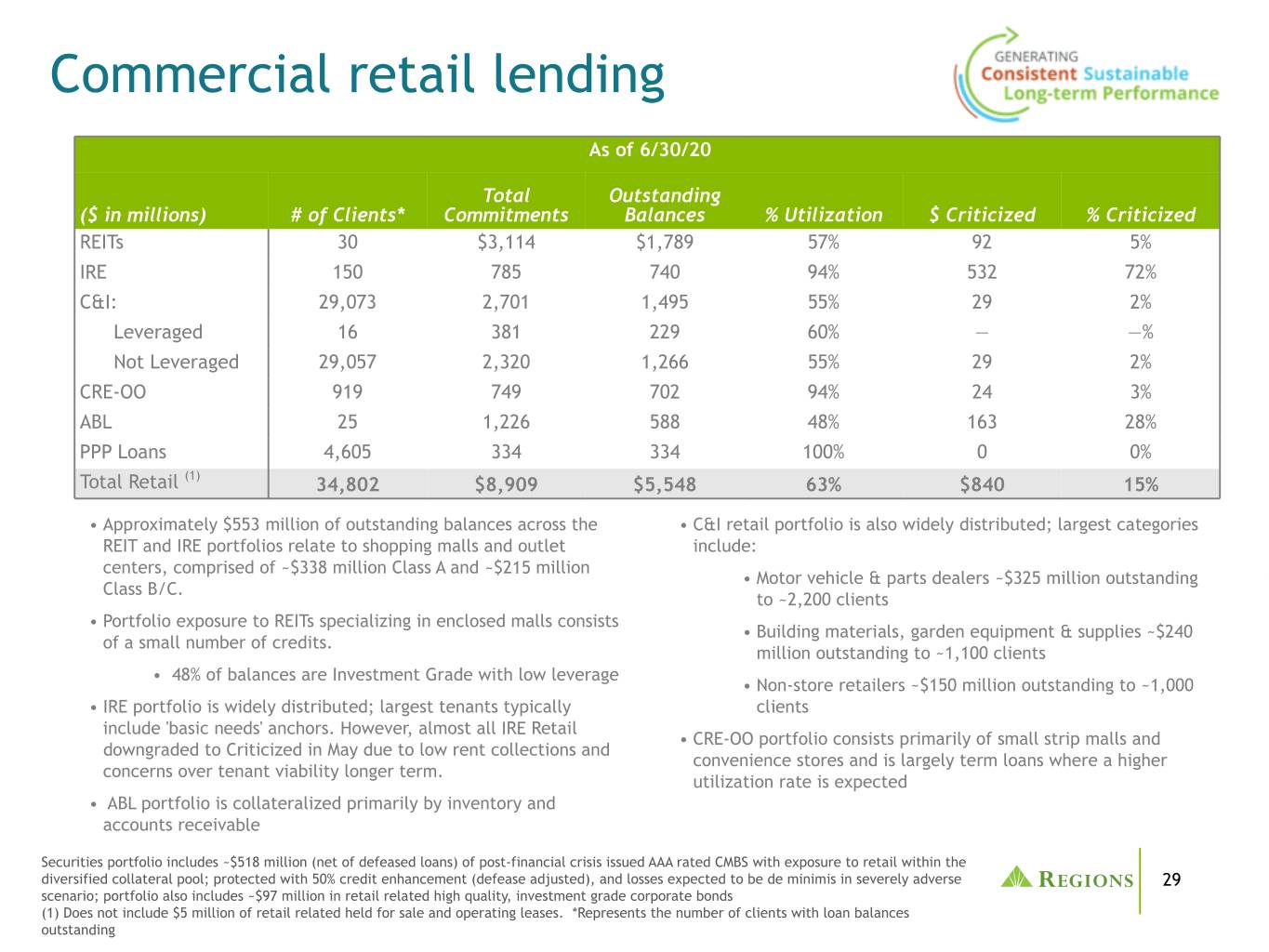
Commercial retail lending As of 6/30/20 Total Outstanding ($ in millions) # of Clients* Commitments Balances % Utilization $ Criticized % Criticized REITs 30 $3,114 $1,789 57% 92 5% IRE 150 785 740 94% 532 72% C&I: 29,073 2,701 1,495 55% 29 2% Leveraged 16 381 229 60% — —% Not Leveraged 29,057 53 2,320 1,266 55% 29 2% CRE-OO 919 749 702 94% 24 3% ABL 25 1,226 588 48% 163 28% PPP Loans 4,605 334 334 100% 0 0% Total Retail (1) 34,802 $8,909 $5,548 63% $840 15% • Approximately $553 million of outstanding balances across the • C&I retail portfolio is also widely distributed; largest categories REIT and IRE portfolios relate to shopping malls and outlet include: centers, comprised of ~$338 million Class A and ~$215 million • Motor vehicle & parts dealers ~$325 million outstanding Class B/C. to ~2,200 clients • Portfolio exposure to REITs specializing in enclosed malls consists • Building materials, garden equipment & supplies ~$240 of a small number of credits. million outstanding to ~1,100 clients • 48% of balances are Investment Grade with low leverage • Non-store retailers ~$150 million outstanding to ~1,000 • IRE portfolio is widely distributed; largest tenants typically clients include 'basic needs' anchors. However, almost all IRE Retail • CRE-OO portfolio consists primarily of small strip malls and downgraded to Criticized in May due to low rent collections and convenience stores and is largely term loans where a higher concerns over tenant viability longer term. utilization rate is expected • ABL portfolio is collateralized primarily by inventory and accounts receivable Securities portfolio includes ~$518 million (net of defeased loans) of post-financial crisis issued AAA rated CMBS with exposure to retail within the diversified collateral pool; protected with 50% credit enhancement (defease adjusted), and losses expected to be de minimis in severely adverse 29 scenario; portfolio also includes ~$97 million in retail related high quality, investment grade corporate bonds (1) Does not include $5 million of retail related held for sale and operating leases. *Represents the number of clients with loan balances outstanding
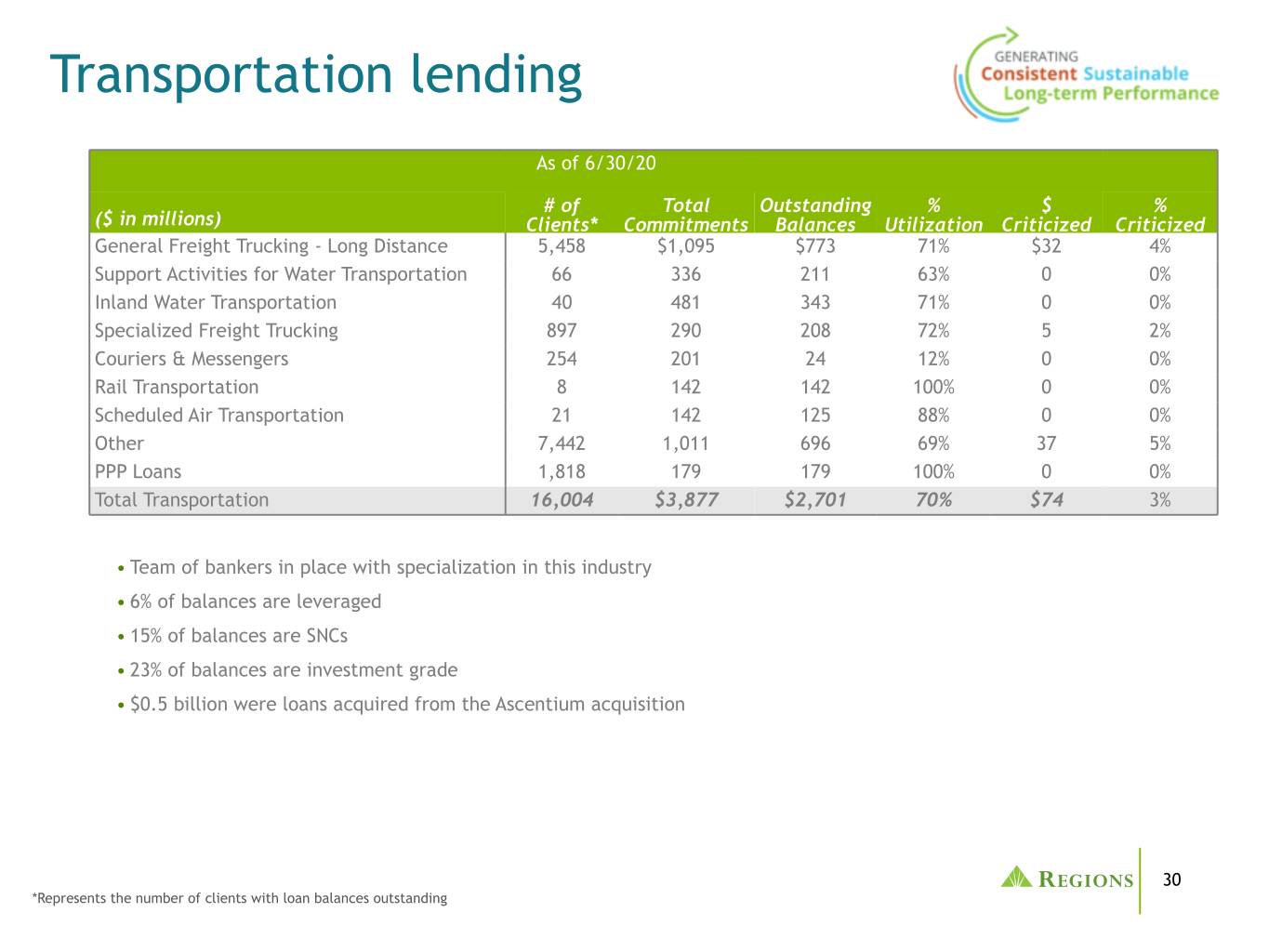
Transportation lending As of 6/30/20 # of Total Outstanding % $ % ($ in millions) Clients* Commitments Balances Utilization Criticized Criticized General Freight Trucking - Long Distance 5,458 $1,095 $773 71% $32 4% Support Activities for Water Transportation 66 336 211 63% 0 0% Inland Water Transportation 40 481 343 71% 0 0% Specialized Freight Trucking 897 290 208 72% 5 2% Couriers & Messengers 53 254 201 24 12% 0 0% Rail Transportation 8 142 142 100% 0 0% Scheduled Air Transportation 21 142 125 88% 0 0% Other 7,442 1,011 696 69% 37 5% PPP Loans 1,818 179 179 100% 0 0% Total Transportation 16,004 $3,877 $2,701 70% $74 3% • Team of bankers in place with specialization in this industry • 6% of balances are leveraged • 15% of balances are SNCs • 23% of balances are investment grade • $0.5 billion were loans acquired from the Ascentium acquisition 30 *Represents the number of clients with loan balances outstanding
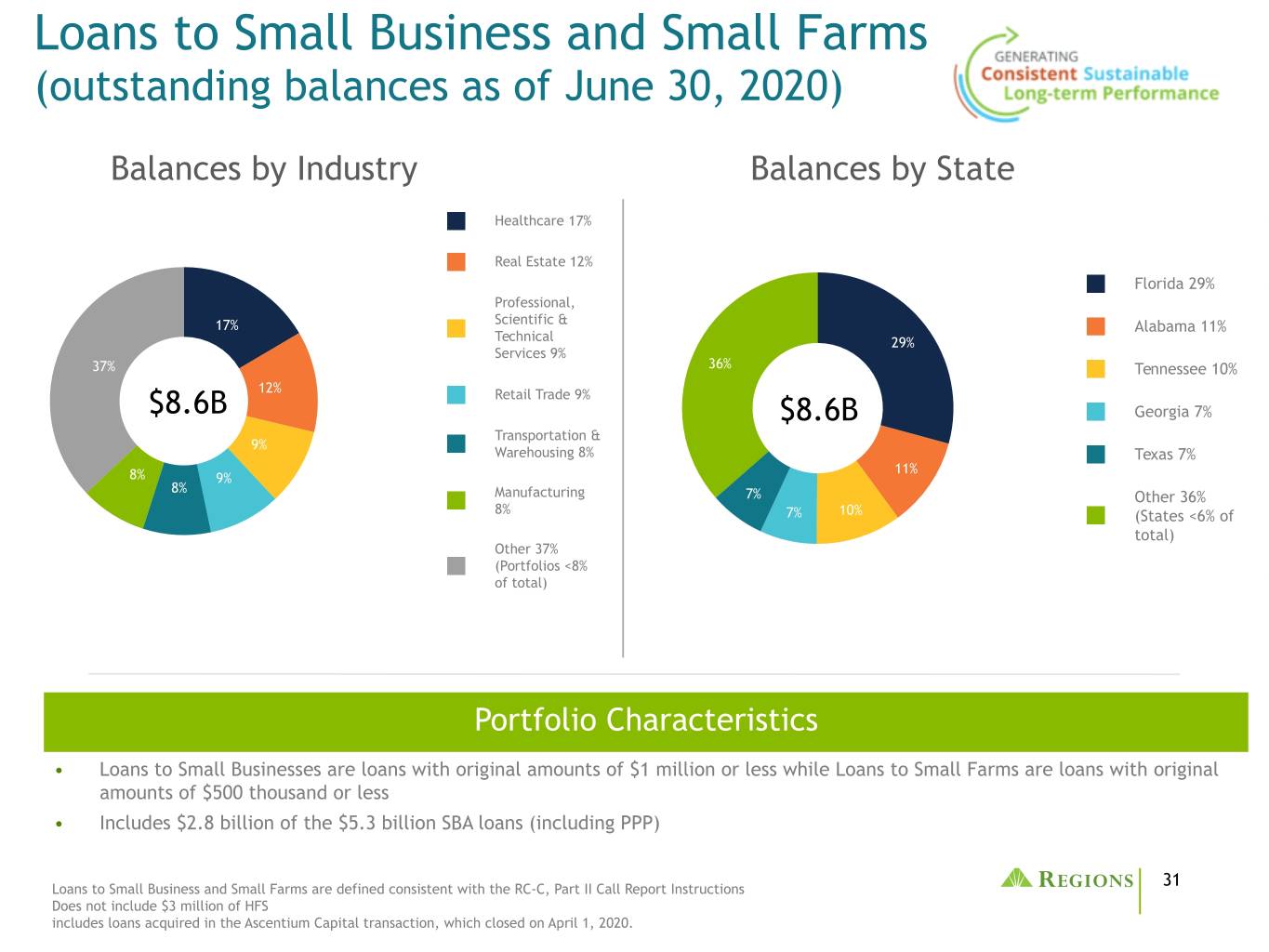
Loans to Small Business and Small Farms (outstanding balances as of June 30, 2020) Balances by Industry Balances by State Healthcare 17% Real Estate 12% Florida 29% Professional, 17% Scientific & Alabama 11% Technical 29% Services 9% 37% 36% Tennessee 10% 12% Retail Trade 9% $8.6B $8.6B Georgia 7% Transportation & 9% Warehousing 8% Texas 7% 11% 8% 9% 8% Manufacturing 7% Other 36% 8% 7% 10% (States <6% of total) Other 37% (Portfolios <8% of total) Portfolio Characteristics • Loans to Small Businesses are loans with original amounts of $1 million or less while Loans to Small Farms are loans with original amounts of $500 thousand or less • Includes $2.8 billion of the $5.3 billion SBA loans (including PPP) 31 Loans to Small Business and Small Farms are defined consistent with the RC-C, Part II Call Report Instructions Does not include $3 million of HFS includes loans acquired in the Ascentium Capital transaction, which closed on April 1, 2020.

SBA loans (outstanding balances as of June 30, 2020) Balances by Industry Balances by State Healthcare 14% Manufacturing 14% Florida 29% Real Estate 12% 14% Alabama 15% 23% 25% Professional, 29% Scientific 11% Tennessee 12% 14% Restaurant, 8% $5.3B Accommodation $5.3B Georgia 10% & Lodging 10% 9% 8% 12% Texas 9% Retail Trade 8% 10% 11% 15% 10% Other 25% Religious, 12% (States <9% of Leisure 8% total) Other 23% (Portfolios <8% of total) Portfolio Characteristics • 85% are PPP Loans, 10% are 7(a) Program Loans; 5% are 504 Program Loans • $2.8 billion fall into the Loans to Small Business and Small Farms • 95% are wholly or partially guaranteed by the US Government The 7(a) Program loans can be used to buy a business or obtain working capital. The 504 Program loans provide commercial real estate financing 32 for owner-occupied properties. Loans to Small Business and Small Farms are defined consistent with the RC-C, Part II Call Report Instructions Does not include $1 million of HFS

Consumer lending portfolio statistics Residential Mortgage Home Equity • Avg. origination FICO 751 • Avg. origination FICO 757 • Current LTV 59% • Current LTV 45% • 96% owner occupied • Only $134M of resets through 2021 • 68% of portfolio is 1st lien • Avg. loan size $38,518 Consumer Credit Card Consumer Third-Party Lending Other Consumer Unsecured • Avg. origination FICO 771 • Avg. origination FICO 755 • Avg. origination FICO 737 • Avg. new line $4,803 • Avg. new line $34,329 • Avg. new loan $9,897 • 2Q20 Yield 11.65% • 42% home improvement loans • 2Q20 QTD NCO 4.41% • 2Q20 Yield 8.36% • 2Q20 QTD NCO 2.35% 33

LIBOR transition Four pillars of execution ◦ Regions completed a comprehensive LIBOR Impact Assessment in 1H 2019 ◦ Regions has established an Executive Steering Committee to guide program decisions and transition strategy. ◦ Regions has begun enterprise-wide efforts to transition to alternative rates consistent with industry timelines. Core Products & Financial Strategy & Contracts Communications Integration Forecasting How do we adjust existing How do we forecast for the How will we treat existing When and how do we platforms and prepare to transition and measure its contracts and incorporate communicate effectively to offer a new rate(s)? impact over time? industry fallback language? all stakeholders? Cross functional team Cross functional team Cross functional team Cross functional team • Strategic Planning • Corporate Banking Group • Corporate Banking Group • Corporate Banking Group • Treasury • Consumer Banking Group • Consumer Banking Group • Consumer Banking Group • Accounting • Private Wealth Mgt. • Private Wealth Mgt. • Private Wealth Mgt. • Finance • Capital Markets • Capital Markets • Capital Markets • Capital Markets • Ops & Tech • Risk Testing Organization • Marketing • Corporate Banking Group • Finance • Legal • Investor Relations • Consumer Banking Group • Risk • Ops & Tech • Learning & Development • Ops & Tech Topics • Legal • Risk Topics • Technology solutions to • Corporate Communications • Loan origination process search and catalog LIBOR- Topics • System updates based contracts Topics • Financial forecasting • Derivative systems • Regions360 approach • Client education • Loan pricing • Business deposits (clients w/ multiple • Associate training • Financial objectives • New swap arrangements products) • External communication • Corporate hedging • Update fallback language • Disclosures 34

Non-GAAP information Management uses pre-tax pre-provision income (non-GAAP) and adjusted pre-tax pre-provision income (non-GAAP), as well as the adjusted efficiency ratio (non-GAAP) and the adjusted fee income ratio (non-GAAP) to monitor performance and believes these measures provide meaningful information to investors. Non-interest expense (GAAP) is presented excluding certain adjustments to arrive at adjusted non-interest expense (non-GAAP), which is the numerator for the efficiency ratio. Non-interest income (GAAP) is presented excluding certain adjustments to arrive at adjusted non-interest income (non-GAAP), which is the numerator for the fee income ratio. Adjusted non-interest income (non-GAAP) and adjusted non-interest expense (non- GAAP) are used to determine adjusted pre-tax pre-provision income (non-GAAP). Net interest income (GAAP) on a taxable-equivalent basis and non-interest income are added together to arrive at total revenue on a taxable-equivalent basis. Adjustments are made to arrive at adjusted total revenue on a taxable-equivalent basis (non-GAAP), which is the denominator for the fee income and efficiency ratios. Regions believes that the exclusion of these adjustments provides a meaningful base for period-to-period comparisons, which management believes will assist investors in analyzing the operating results of the Company and predicting future performance. These non-GAAP financial measures are also used by management to assess the performance of Regions’ business. It is possible that the activities related to the adjustments may recur; however, management does not consider the activities related to the adjustments to be indications of ongoing operations. Regions believes that presentation of these non-GAAP financial measures will permit investors to assess the performance of the Company on the same basis as that applied by management. The allowance for credit losses (ACL) as a percentage of total loans is an important ratio, especially during periods of economic stress. Management believes this ratio provides investors with meaningful additional information about credit loss allowance levels when the SBA's Paycheck Protection Program loans, which are fully backed by the U.S. government, are excluded from total loans which is the denominator used in the ACL ratio. This adjusted ACL ratio represents a non-GAAP financial measure. Tangible common stockholders’ equity ratios have become a focus of some investors and management believes they may assist investors in analyzing the capital position of the Company absent the effects of intangible assets and preferred stock. Analysts and banking regulators have assessed Regions’ capital adequacy using the tangible common stockholders’ equity measure. Because tangible common stockholders’ equity is not formally defined by GAAP or prescribed in any amount by federal banking regulations it is currently considered to be a non- GAAP financial measure and other entities may calculate it differently than Regions’ disclosed calculations. Since analysts and banking regulators may assess Regions’ capital adequacy using tangible common stockholders’ equity, management believes that it is useful to provide investors the ability to assess Regions’ capital adequacy on this same basis. Non-GAAP financial measures have inherent limitations, are not required to be uniformly applied and are not audited. Although these non-GAAP financial measures are frequently used by stakeholders in the evaluation of a company, they have limitations as analytical tools, and should not be considered in isolation, or as a substitute for analyses of results as reported under GAAP. In particular, a measure of earnings that excludes selected items does not represent the amount that effectively accrues directly to stockholders. Management and the Board of Directors utilize non-GAAP measures as follows: • Preparation of Regions' operating budgets • Monthly financial performance reporting • Monthly close-out reporting of consolidated results (management only) • Presentation to investors of company performance 35

Non-GAAP and additional selected items impacting earnings Quarter Ended (amounts in millions, except per share data) 6/30/2020 3/31/2020 6/30/2019 Selected items impacting earnings: Pre-tax adjusted items(1): Branch consolidation, property and equipment charges $ (10) $ (11) $ (2) Loss on early extinguishment of debt (6) — — Salaries and benefits related to severance charges (2) (1) (2) Professional fees related to the purchase of Ascentium Capital (7) — — Other Ascentium acquisition expenses (1) — — Securities gains (losses), net 1 — (19) Leveraged lease termination gains — 2 — Total pre-tax adjusted items(1) $ (25) $ (10) $ (23) Diluted EPS impact* $ (0.02) $ (0.01) $ (0.02) Pre-tax additional selected items**: CECL provision in excess of net charge-offs*** $ (700) $ (250) $ — Capital markets income - CVA/DVA 34 (34) (7) MSR net hedge performance 2 14 (7) PPP loans net interest income 16 — — COVID-19 related expenses (19) (4) — Total pre-tax additional selected items** $ (667) $ (274) $ (14) * Based on income taxes at an approximate 25% incremental rate. Tax rates associated with leveraged lease terminations are incrementally 36 higher based on their structure. ** Items represent an outsized or unusual impact to the quarter or quarterly trends, but are not considered non-GAAP adjustments. ***CECL was adopted 1/1/2020. Periods prior to January 1, 2020 reflect results under the incurred loss model.

Non-GAAP reconciliation: adjusted average loans Average Balances ($ amounts in millions) 2Q20 1Q20 4Q19 3Q19 2Q19 2Q20 vs. 1Q20 2Q20 vs. 2Q19 Total consumer loans $ 29,845 $ 30,250 $ 30,418 $ 30,527 $ 30,807 $ (405) (1.3)% $ (962) (3.1)% Less: Indirect—vehicles 1,441 1,679 1,948 2,247 2,578 (238) (14.2)% (1,137) (44.1)% Adjusted total consumer loans (non-GAAP) $ 28,404 $ 28,571 $ 28,470 $ 28,280 $ 28,229 $ (167) (0.6)% $ 175 0.6 % Total loans $ 91,964 $ 83,249 $ 82,392 $ 82,986 $ 83,905 $ 8,715 10.5 % $ 8,059 9.6 % Less: Indirect—vehicles 1,441 1,679 1,948 2,247 2,578 (238) (14.2)% (1,137) (44.1)% Adjusted total loans (non-GAAP) $ 90,523 $ 81,570 $ 80,444 $ 80,739 $ 81,327 $ 8,953 11.0 % $ 9,196 11.3 % 37

Non-GAAP reconciliation: NII, non-interest income/expense, operating leverage and efficiency ratio Quarter Ended ($ amounts in millions) 6/30/2020 3/31/2020 12/31/2019 9/30/2019 6/30/2019 2Q20 vs. 1Q20 2Q20 vs. 2Q19 Non-interest expense (GAAP) A $ 924 $ 836 $ 897 $ 871 $ 861 $ 88 10.5 % $ 63 7.3 % Adjustments: Branch consolidation, property and equipment charges (10) (11) (12) (5) (2) 1 9.1 % (8) (400.0)% Salary and employee benefits—severance charges (2) (1) — (1) (2) (1) (100.0)% — — % Loss on early extinguishment of debt (6) — (16) — — (6) NM (6) NM Professional, legal and regulatory expenses (7) — — — — (7) NM (7) NM Acquisition expenses (1) — — — — (1) NM (1) NM Adjusted non-interest expense (non-GAAP) B $ 898 $ 824 $ 869 $ 865 $ 857 $ 74 9.0 % $ 41 4.8 % Net interest income (GAAP) C $ 972 $ 928 $ 918 $ 937 $ 942 $ 44 4.7 % $ 30 3.2 % Taxable-equivalent adjustment 13 12 13 13 14 1 8.3 % (1) (7.1)% Net interest income, taxable-equivalent basis D $ 985 $ 940 $ 931 $ 950 $ 956 $ 45 4.8 % $ 29 3.0 % Non-interest income (GAAP) E 573 485 562 558 494 88 18.1 79 16.0 Adjustments: Securities (gains) losses, net (1) — 2 — 19 (1) NM (20) (105.3)% Leveraged lease termination gains — (2) — (1) — 2 100.0 % — NM Adjusted non-interest income (non-GAAP) F $ 572 $ 483 $ 564 $ 557 $ 513 $ 89 18.4 % $ 59 11.5 % Total revenue C+E=G $ 1,545 $ 1,413 $ 1,480 $ 1,495 $ 1,436 $132 9.3 % $109 7.6 % Adjusted total revenue (non-GAAP) C+F=H $ 1,544 $ 1,411 $ 1,482 $ 1,494 $ 1,455 $133 9.4 % $ 89 6.1 % Total revenue, taxable-equivalent basis D+E=I $ 1,558 $ 1,425 $ 1,493 $ 1,508 $ 1,450 $133 9.3 % $108 7.4 % Adjusted total revenue, taxable-equivalent basis (non-GAAP) D+F=J $ 1,557 $ 1,423 $ 1,495 $ 1,507 $ 1,469 $134 9.4 % $ 88 6.0 % Efficiency ratio (GAAP) A/I 59.4% 58.6% 60.1% 57.7% 59.4% Adjusted efficiency ratio (non-GAAP) B/J 57.7% 57.9% 58.1% 57.4% 58.3% Fee income ratio (GAAP) E/I 36.8% 34.0% 37.6% 37.0% 34.1% Adjusted fee income ratio (non-GAAP) F/J 36.8% 34.0% 37.7% 37.0% 35.0% NM - Not Meaningful 38
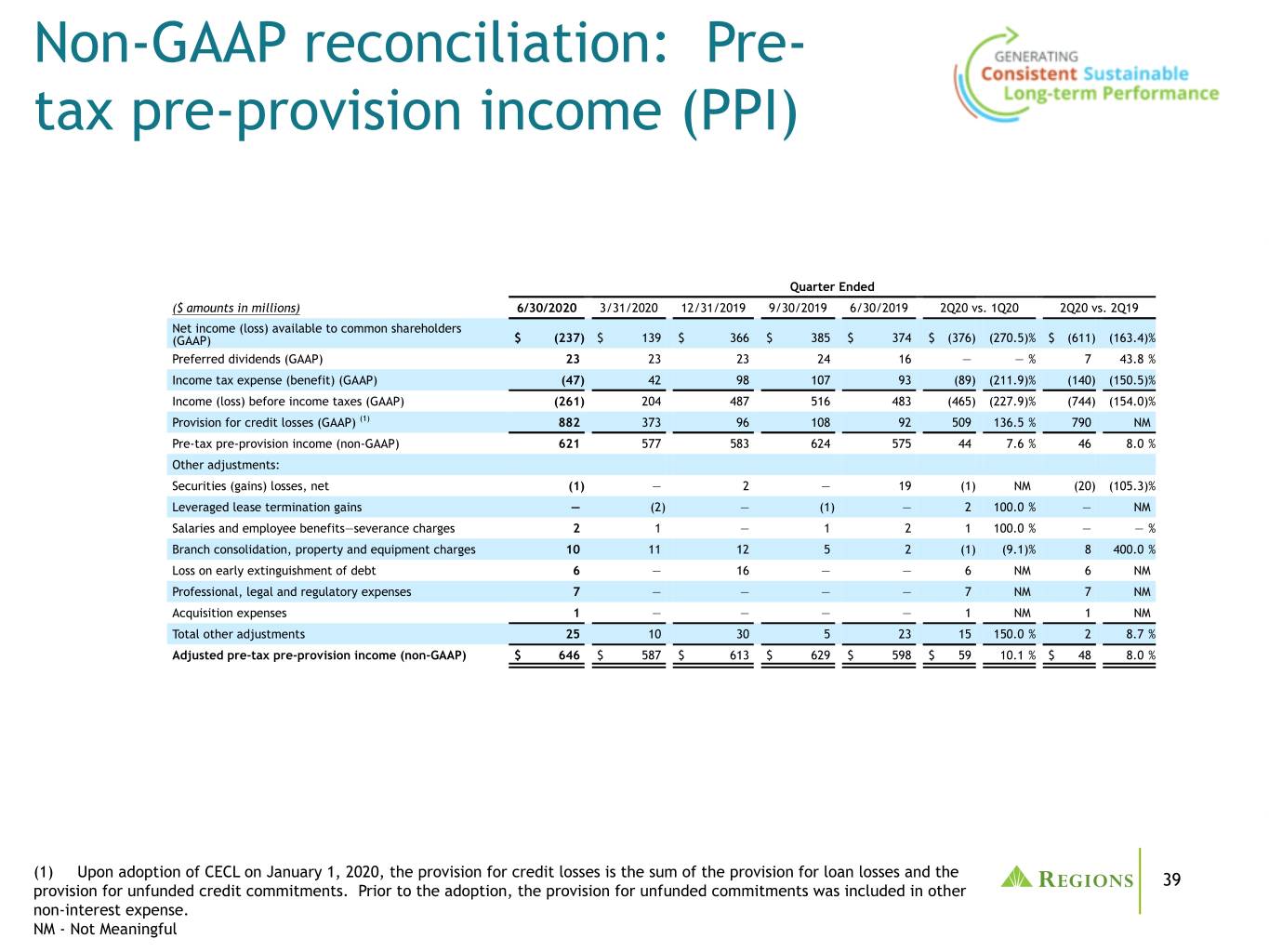
Non-GAAP reconciliation: Pre- tax pre-provision income (PPI) Quarter Ended ($ amounts in millions) 6/30/2020 3/31/2020 12/31/2019 9/30/2019 6/30/2019 2Q20 vs. 1Q20 2Q20 vs. 2Q19 Net income (loss) available to common shareholders (GAAP) $ (237) $ 139 $ 366 $ 385 $ 374 $ (376) (270.5)% $ (611) (163.4)% Preferred dividends (GAAP) 23 23 23 24 16 — — % 7 43.8 % Income tax expense (benefit) (GAAP) (47) 42 98 107 93 (89) (211.9)% (140) (150.5)% Income (loss) before income taxes (GAAP) (261) 204 487 516 483 (465) (227.9)% (744) (154.0)% Provision for credit losses (GAAP) (1) 882 373 96 108 92 509 136.5 % 790 NM Pre-tax pre-provision income (non-GAAP) 621 577 583 624 575 44 7.6 % 46 8.0 % Other adjustments: Securities (gains) losses, net (1) — 2 — 19 (1) NM (20) (105.3)% Leveraged lease termination gains — (2) — (1) — 2 100.0 % — NM Salaries and employee benefits—severance charges 2 1 — 1 2 1 100.0 % — — % Branch consolidation, property and equipment charges 10 11 12 5 2 (1) (9.1)% 8 400.0 % Loss on early extinguishment of debt 6 — 16 — — 6 NM 6 NM Professional, legal and regulatory expenses 7 — — — — 7 NM 7 NM Acquisition expenses 1 — — — — 1 NM 1 NM Total other adjustments 25 10 30 5 23 15 150.0 % 2 8.7 % Adjusted pre-tax pre-provision income (non-GAAP) $ 646 $ 587 $ 613 $ 629 $ 598 $ 59 10.1 % $ 48 8.0 % (1) Upon adoption of CECL on January 1, 2020, the provision for credit losses is the sum of the provision for loan losses and the 39 provision for unfunded credit commitments. Prior to the adoption, the provision for unfunded commitments was included in other non-interest expense. NM - Not Meaningful

Forward-looking statements Forward-Looking Statements This release may include forward-looking statements as defined in the Private Securities Litigation Reform Act of 1995. Any statement that does not describe historical or current facts is a forward-looking statement. Forward-looking statements are not based on historical information, but rather are related to future operations, strategies, financial results or other developments. Forward-looking statements are based on management’s current expectations as well as certain assumptions and estimates made by, and information available to, management at the time the statements are made. Those statements are based on general assumptions and are subject to various risks, and because they also relate to the future they are likewise subject to inherent uncertainties and other factors that may cause actual results to differ materially from the views, beliefs and projections expressed in such statements. Therefore, we caution you against relying on any of these forward-looking statements. These risks, uncertainties and other factors include, but are not limited to, those described below: • Current and future economic and market conditions in the United States generally or in the communities we serve (in particular the Southeastern United States), including the effects of possible declines in property values, increases in unemployment rates, financial market disruptions and potential reductions of economic growth, which may adversely affect our lending and other businesses and our financial results and conditions. • Possible changes in trade, monetary and fiscal policies of, and other activities undertaken by, governments, agencies, central banks and similar organizations, which could have a material adverse effect on our earnings. • Possible changes in market interest rates or capital markets could adversely affect our revenue and expense, the value of assets and obligations, and the availability and cost of capital and liquidity. • The impact of pandemics, including the COVID-19 pandemic, on our businesses and financial results and conditions. • Any impairment of our goodwill or other intangibles, any repricing of assets, or any adjustment of valuation allowances on our deferred tax assets due to changes in law, adverse changes in the economic environment, declining operations of the reporting unit or other factors. • The effect of changes in tax laws, including the effect of any future interpretations of or amendments to Tax Reform, which may impact our earnings, capital ratios and our ability to return capital to stockholders. • Possible changes in the creditworthiness of customers and the possible impairment of the collectability of loans and leases, including operating leases. • Changes in the speed of loan prepayments, loan origination and sale volumes, charge-offs, loan loss provisions or actual loan losses where our allowance for loan losses may not be adequate to cover our eventual losses. • Possible acceleration of prepayments on mortgage-backed securities due to low interest rates, and the related acceleration of premium amortization on those securities. • Loss of customer checking and savings account deposits as customers pursue other, higher-yield investments, which could increase our funding costs. • Possible changes in consumer and business spending and saving habits and the related effect on our ability to increase assets and to attract deposits, which could adversely affect our net income. • Our ability to effectively compete with other traditional and non-traditional financial services companies, some of whom possess greater financial resources than we do or are subject to different regulatory standards than we are. • Our inability to develop and gain acceptance from current and prospective customers for new products and services and the enhancement of existing products and services to meet customers’ needs and respond to emerging technological trends in a timely manner could have a negative impact on our revenue. • Our inability to keep pace with technological changes could result in losing business to competitors. • Changes in laws and regulations affecting our businesses, including legislation and regulations relating to bank products and services, as well as changes in the enforcement and interpretation of such laws and regulations by applicable governmental and self-regulatory agencies, which could require us to change certain business practices, increase compliance risk, reduce our revenue, impose additional costs on us, or otherwise negatively affect our businesses. 40
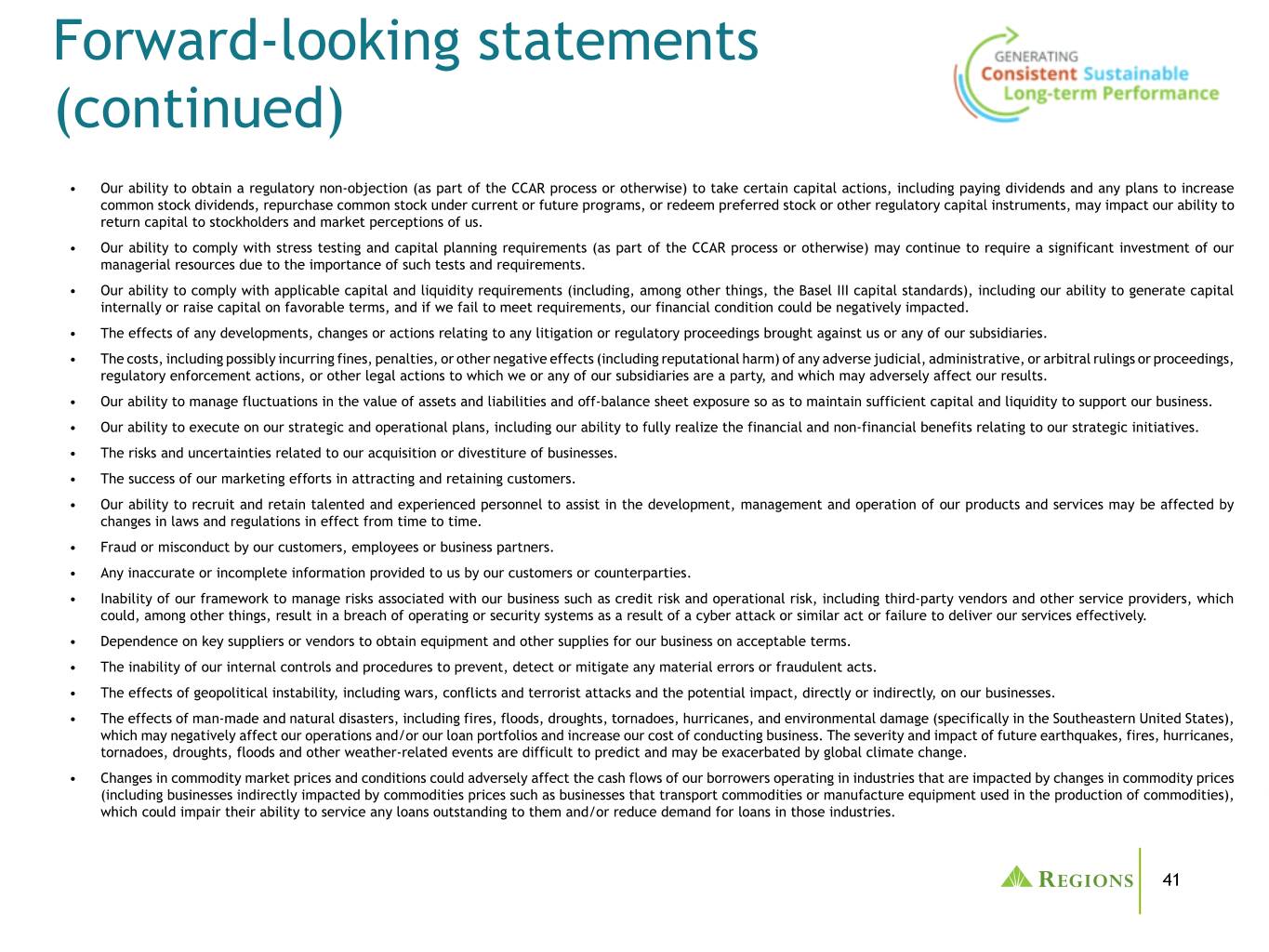
Forward-looking statements (continued) • Our ability to obtain a regulatory non-objection (as part of the CCAR process or otherwise) to take certain capital actions, including paying dividends and any plans to increase common stock dividends, repurchase common stock under current or future programs, or redeem preferred stock or other regulatory capital instruments, may impact our ability to return capital to stockholders and market perceptions of us. • Our ability to comply with stress testing and capital planning requirements (as part of the CCAR process or otherwise) may continue to require a significant investment of our managerial resources due to the importance of such tests and requirements. • Our ability to comply with applicable capital and liquidity requirements (including, among other things, the Basel III capital standards), including our ability to generate capital internally or raise capital on favorable terms, and if we fail to meet requirements, our financial condition could be negatively impacted. • The effects of any developments, changes or actions relating to any litigation or regulatory proceedings brought against us or any of our subsidiaries. • The costs, including possibly incurring fines, penalties, or other negative effects (including reputational harm) of any adverse judicial, administrative, or arbitral rulings or proceedings, regulatory enforcement actions, or other legal actions to which we or any of our subsidiaries are a party, and which may adversely affect our results. • Our ability to manage fluctuations in the value of assets and liabilities and off-balance sheet exposure so as to maintain sufficient capital and liquidity to support our business. • Our ability to execute on our strategic and operational plans, including our ability to fully realize the financial and non-financial benefits relating to our strategic initiatives. • The risks and uncertainties related to our acquisition or divestiture of businesses. • The success of our marketing efforts in attracting and retaining customers. • Our ability to recruit and retain talented and experienced personnel to assist in the development, management and operation of our products and services may be affected by changes in laws and regulations in effect from time to time. • Fraud or misconduct by our customers, employees or business partners. • Any inaccurate or incomplete information provided to us by our customers or counterparties. • Inability of our framework to manage risks associated with our business such as credit risk and operational risk, including third-party vendors and other service providers, which could, among other things, result in a breach of operating or security systems as a result of a cyber attack or similar act or failure to deliver our services effectively. • Dependence on key suppliers or vendors to obtain equipment and other supplies for our business on acceptable terms. • The inability of our internal controls and procedures to prevent, detect or mitigate any material errors or fraudulent acts. • The effects of geopolitical instability, including wars, conflicts and terrorist attacks and the potential impact, directly or indirectly, on our businesses. • The effects of man-made and natural disasters, including fires, floods, droughts, tornadoes, hurricanes, and environmental damage (specifically in the Southeastern United States), which may negatively affect our operations and/or our loan portfolios and increase our cost of conducting business. The severity and impact of future earthquakes, fires, hurricanes, tornadoes, droughts, floods and other weather-related events are difficult to predict and may be exacerbated by global climate change. • Changes in commodity market prices and conditions could adversely affect the cash flows of our borrowers operating in industries that are impacted by changes in commodity prices (including businesses indirectly impacted by commodities prices such as businesses that transport commodities or manufacture equipment used in the production of commodities), which could impair their ability to service any loans outstanding to them and/or reduce demand for loans in those industries. 41
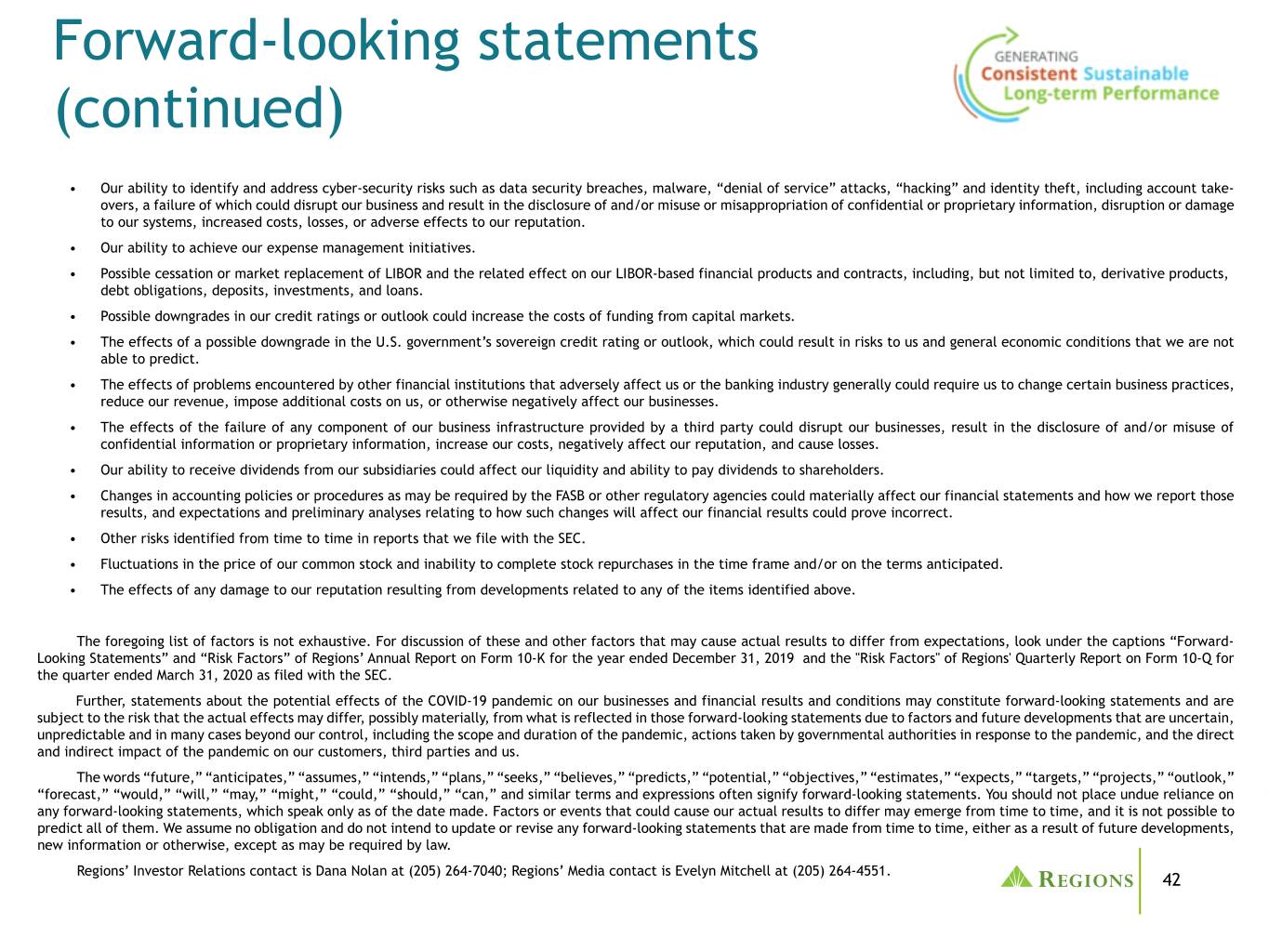
Forward-looking statements (continued) • Our ability to identify and address cyber-security risks such as data security breaches, malware, “denial of service” attacks, “hacking” and identity theft, including account take- overs, a failure of which could disrupt our business and result in the disclosure of and/or misuse or misappropriation of confidential or proprietary information, disruption or damage to our systems, increased costs, losses, or adverse effects to our reputation. • Our ability to achieve our expense management initiatives. • Possible cessation or market replacement of LIBOR and the related effect on our LIBOR-based financial products and contracts, including, but not limited to, derivative products, debt obligations, deposits, investments, and loans. • Possible downgrades in our credit ratings or outlook could increase the costs of funding from capital markets. • The effects of a possible downgrade in the U.S. government’s sovereign credit rating or outlook, which could result in risks to us and general economic conditions that we are not able to predict. • The effects of problems encountered by other financial institutions that adversely affect us or the banking industry generally could require us to change certain business practices, reduce our revenue, impose additional costs on us, or otherwise negatively affect our businesses. • The effects of the failure of any component of our business infrastructure provided by a third party could disrupt our businesses, result in the disclosure of and/or misuse of confidential information or proprietary information, increase our costs, negatively affect our reputation, and cause losses. • Our ability to receive dividends from our subsidiaries could affect our liquidity and ability to pay dividends to shareholders. • Changes in accounting policies or procedures as may be required by the FASB or other regulatory agencies could materially affect our financial statements and how we report those results, and expectations and preliminary analyses relating to how such changes will affect our financial results could prove incorrect. • Other risks identified from time to time in reports that we file with the SEC. • Fluctuations in the price of our common stock and inability to complete stock repurchases in the time frame and/or on the terms anticipated. • The effects of any damage to our reputation resulting from developments related to any of the items identified above. The foregoing list of factors is not exhaustive. For discussion of these and other factors that may cause actual results to differ from expectations, look under the captions “Forward- Looking Statements” and “Risk Factors” of Regions’ Annual Report on Form 10-K for the year ended December 31, 2019 and the "Risk Factors" of Regions' Quarterly Report on Form 10-Q for the quarter ended March 31, 2020 as filed with the SEC. Further, statements about the potential effects of the COVID-19 pandemic on our businesses and financial results and conditions may constitute forward-looking statements and are subject to the risk that the actual effects may differ, possibly materially, from what is reflected in those forward-looking statements due to factors and future developments that are uncertain, unpredictable and in many cases beyond our control, including the scope and duration of the pandemic, actions taken by governmental authorities in response to the pandemic, and the direct and indirect impact of the pandemic on our customers, third parties and us. The words “future,” “anticipates,” “assumes,” “intends,” “plans,” “seeks,” “believes,” “predicts,” “potential,” “objectives,” “estimates,” “expects,” “targets,” “projects,” “outlook,” “forecast,” “would,” “will,” “may,” “might,” “could,” “should,” “can,” and similar terms and expressions often signify forward-looking statements. You should not place undue reliance on any forward-looking statements, which speak only as of the date made. Factors or events that could cause our actual results to differ may emerge from time to time, and it is not possible to predict all of them. We assume no obligation and do not intend to update or revise any forward-looking statements that are made from time to time, either as a result of future developments, new information or otherwise, except as may be required by law. Regions’ Investor Relations contact is Dana Nolan at (205) 264-7040; Regions’ Media contact is Evelyn Mitchell at (205) 264-4551. 42
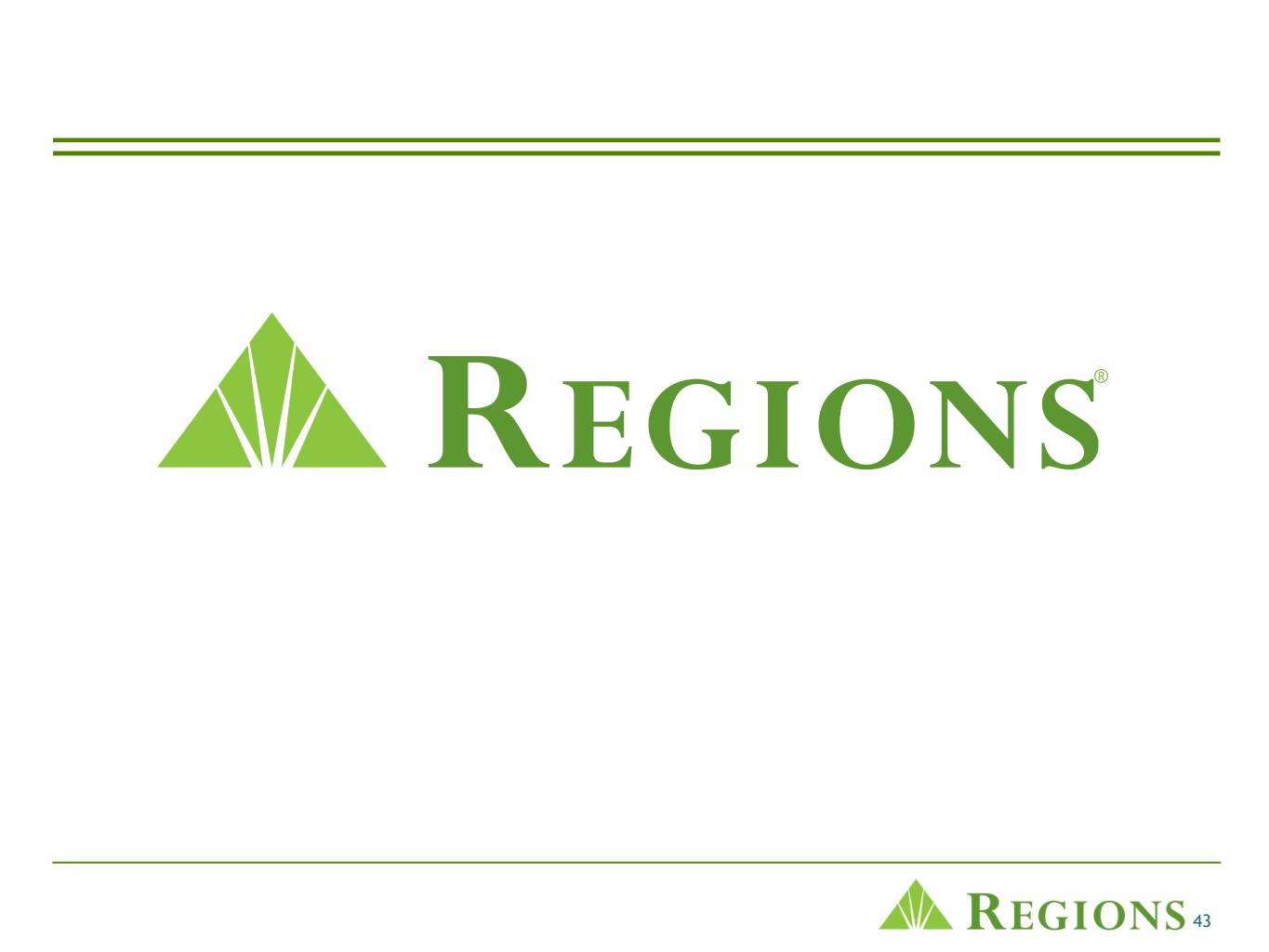
® 43










































